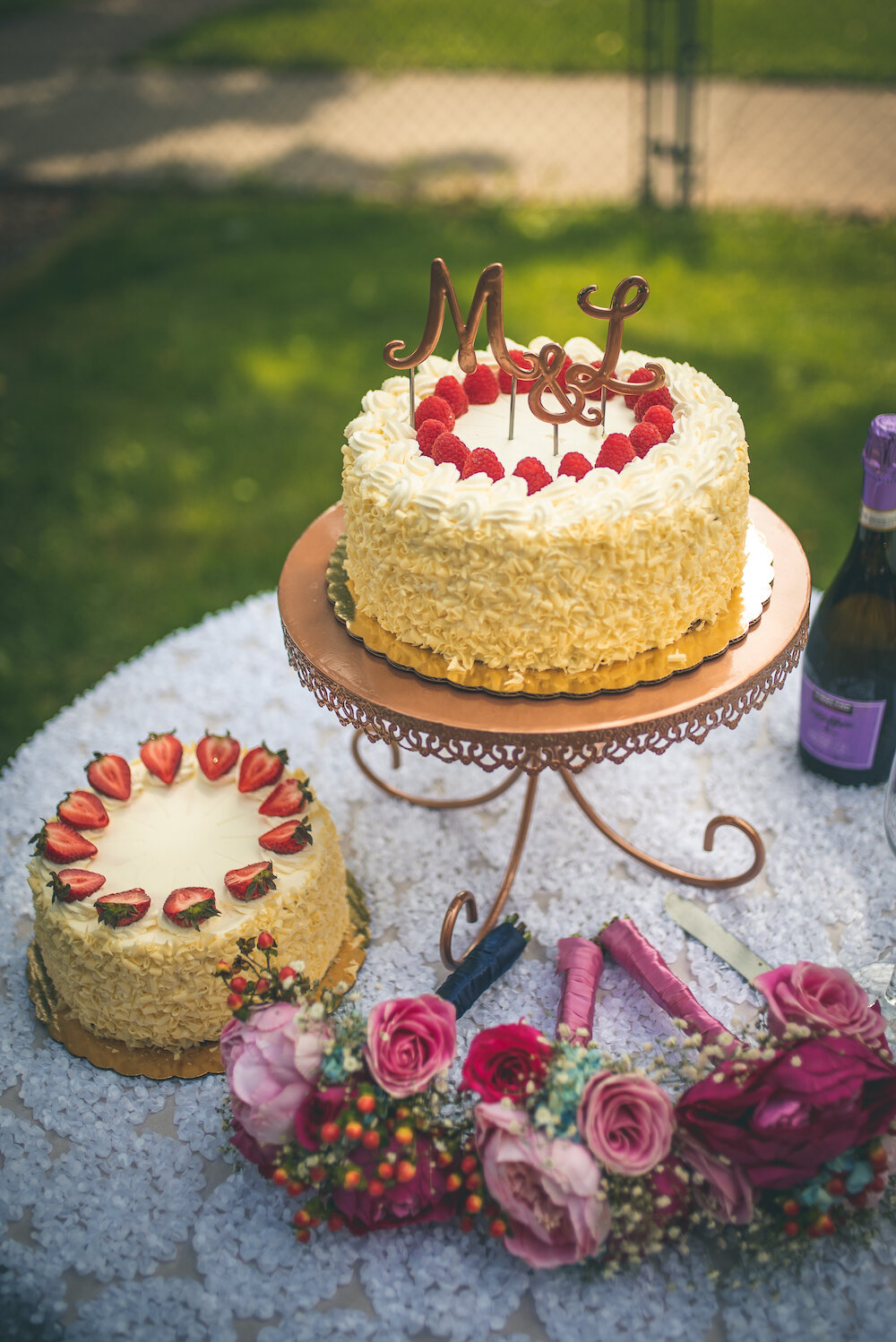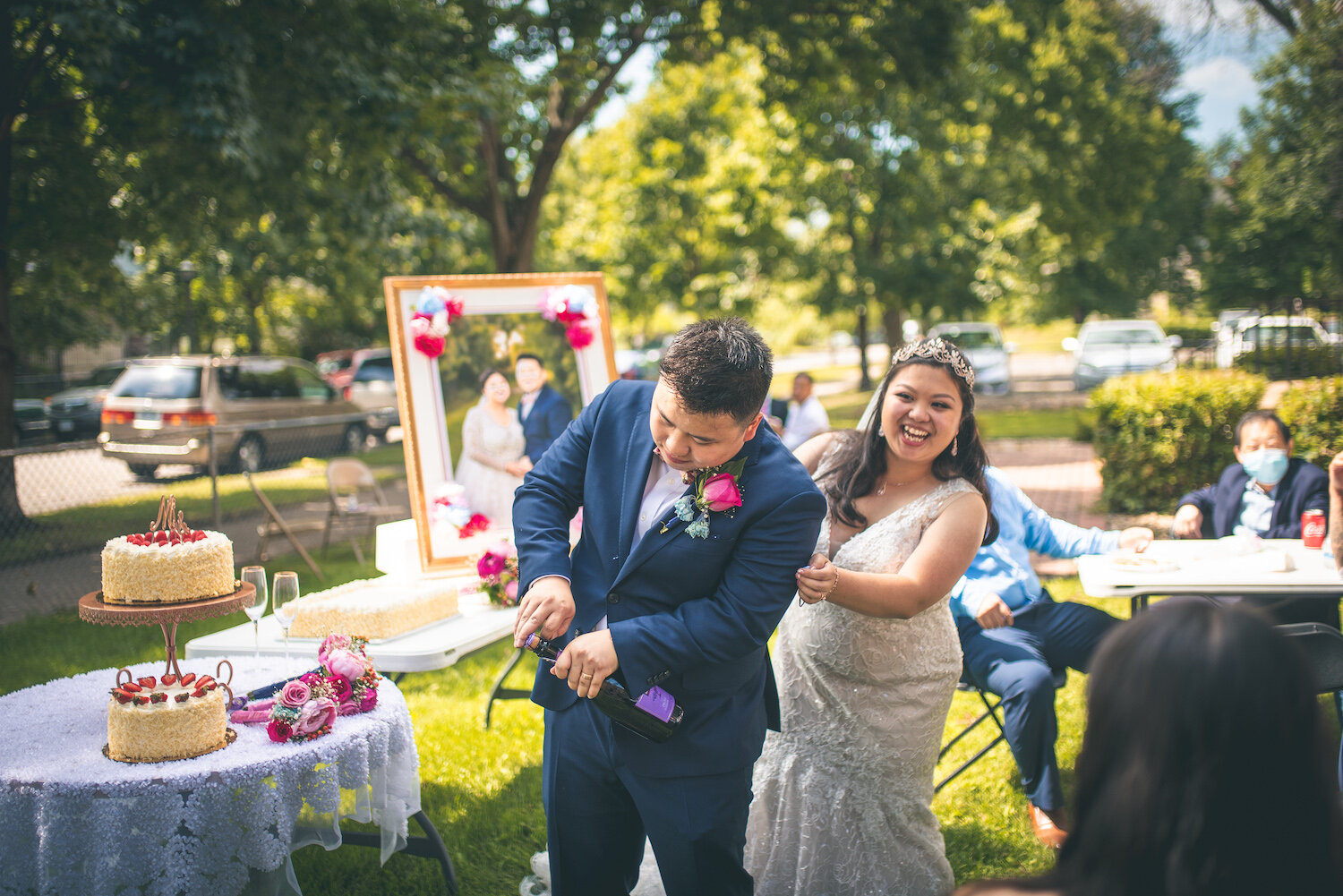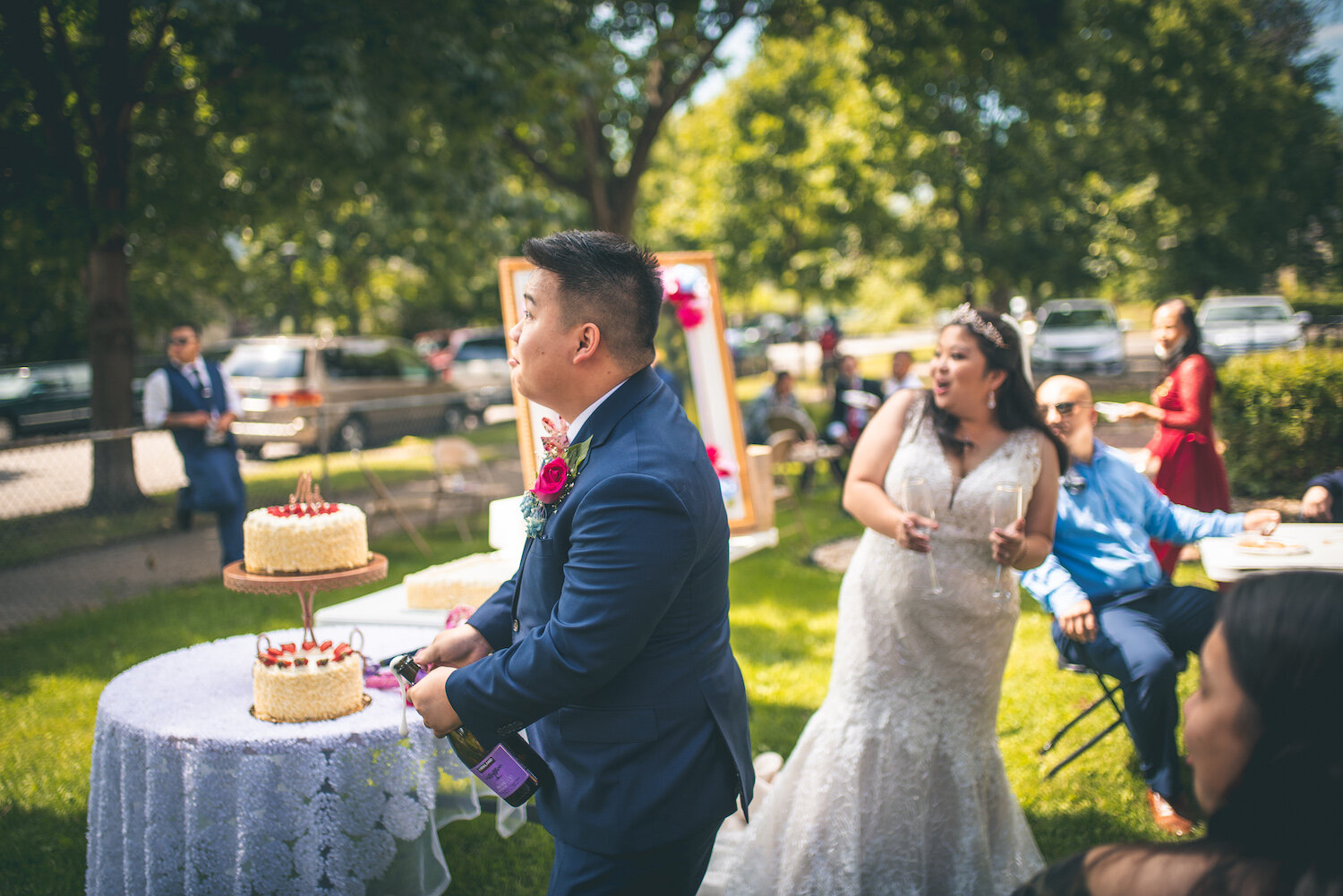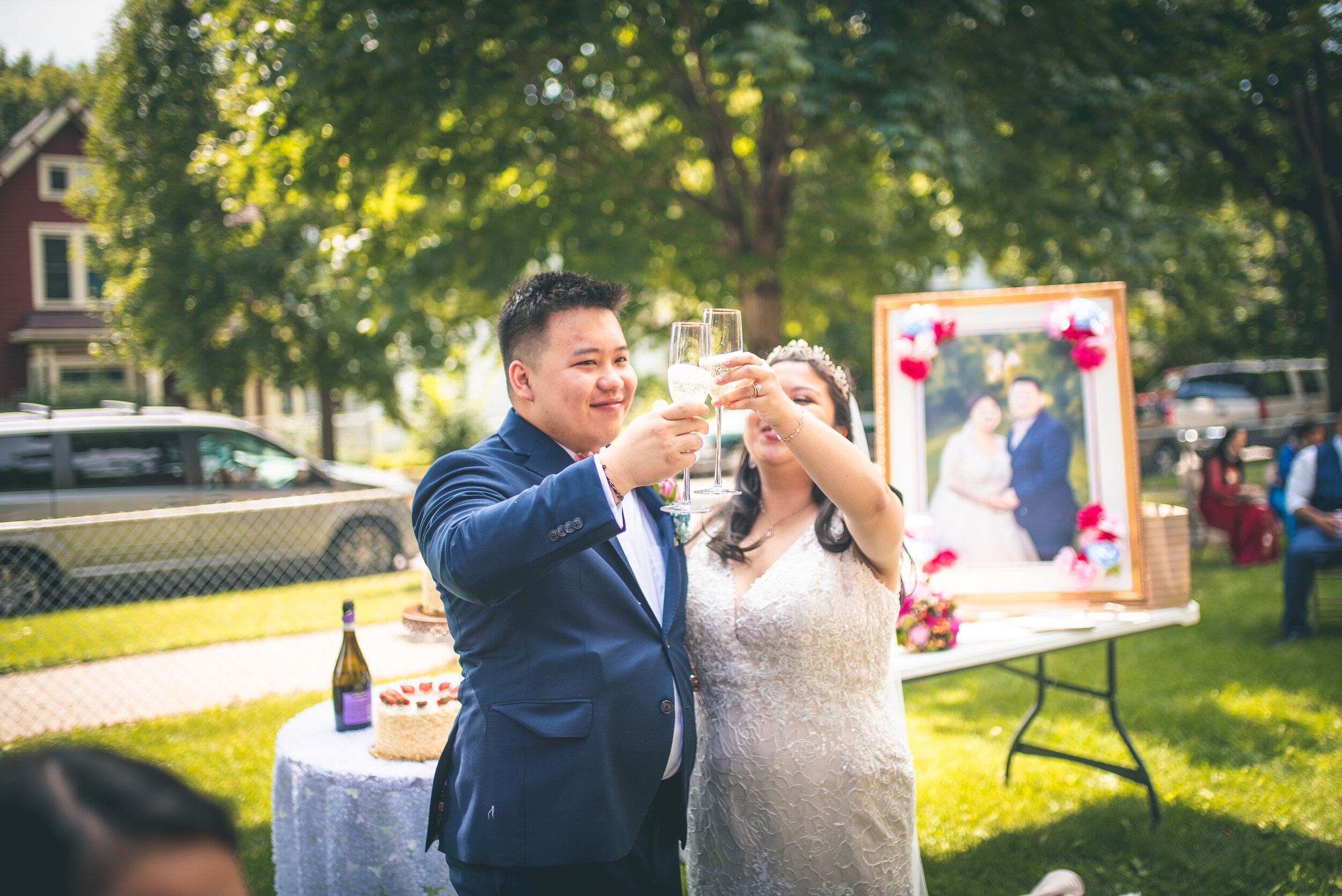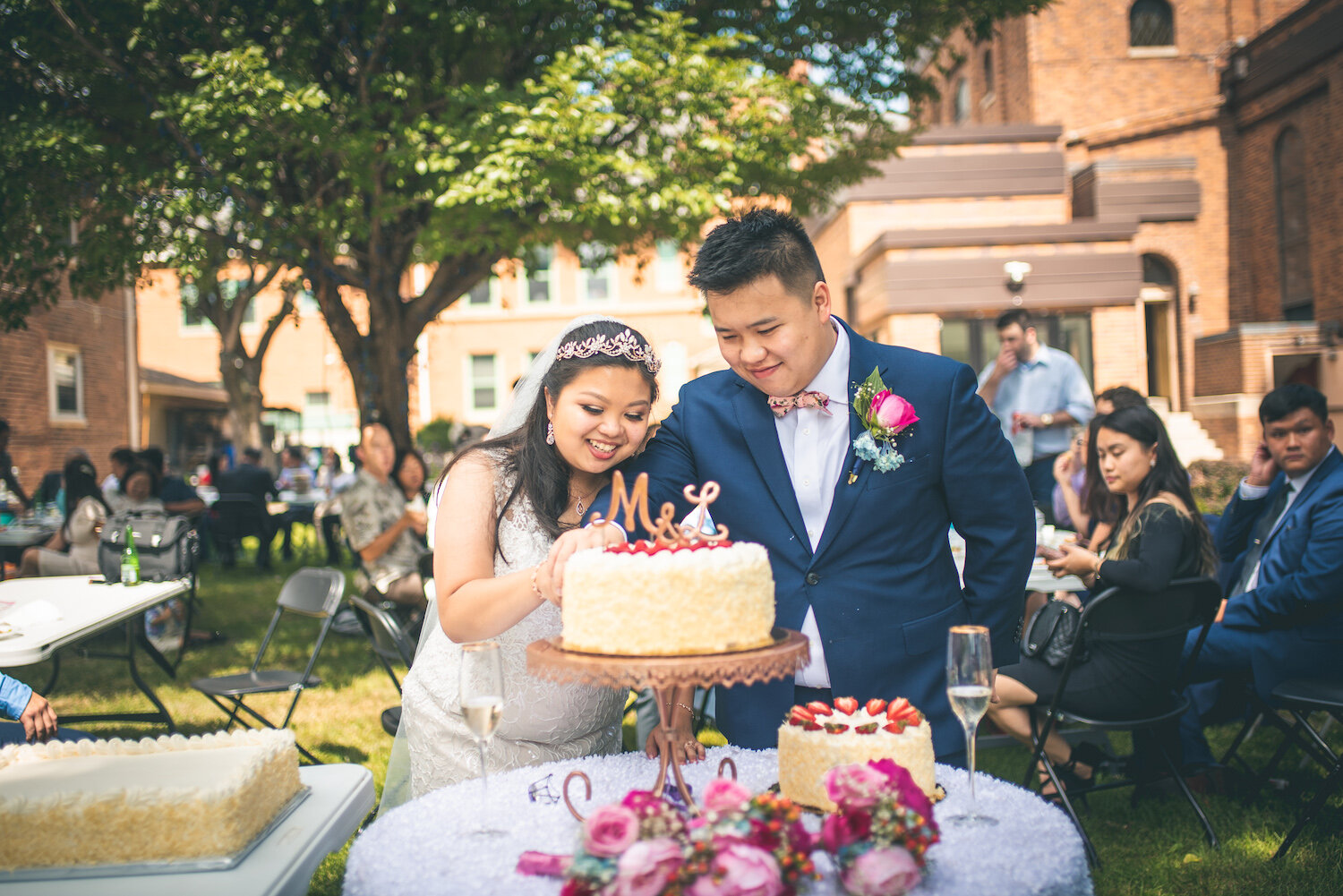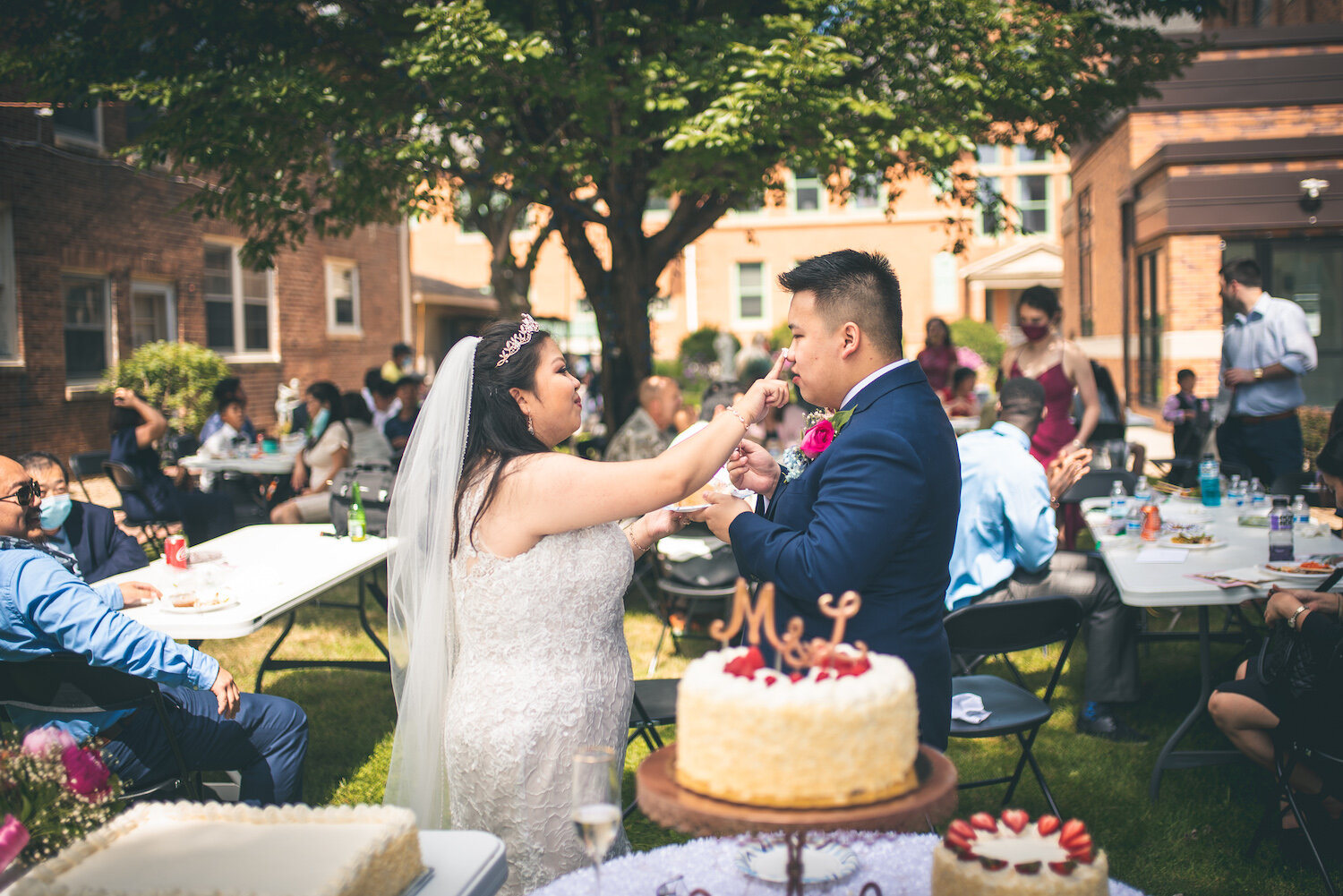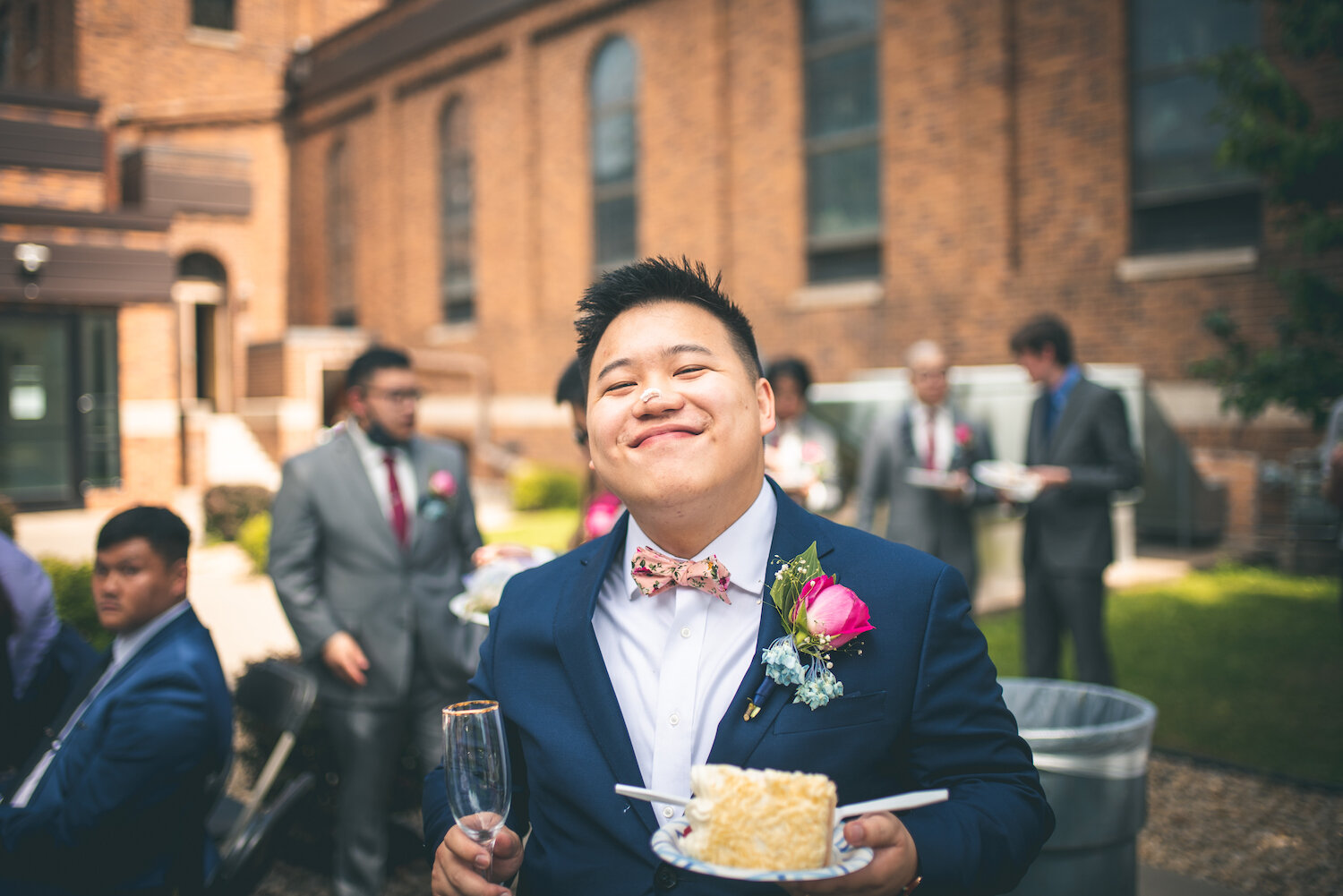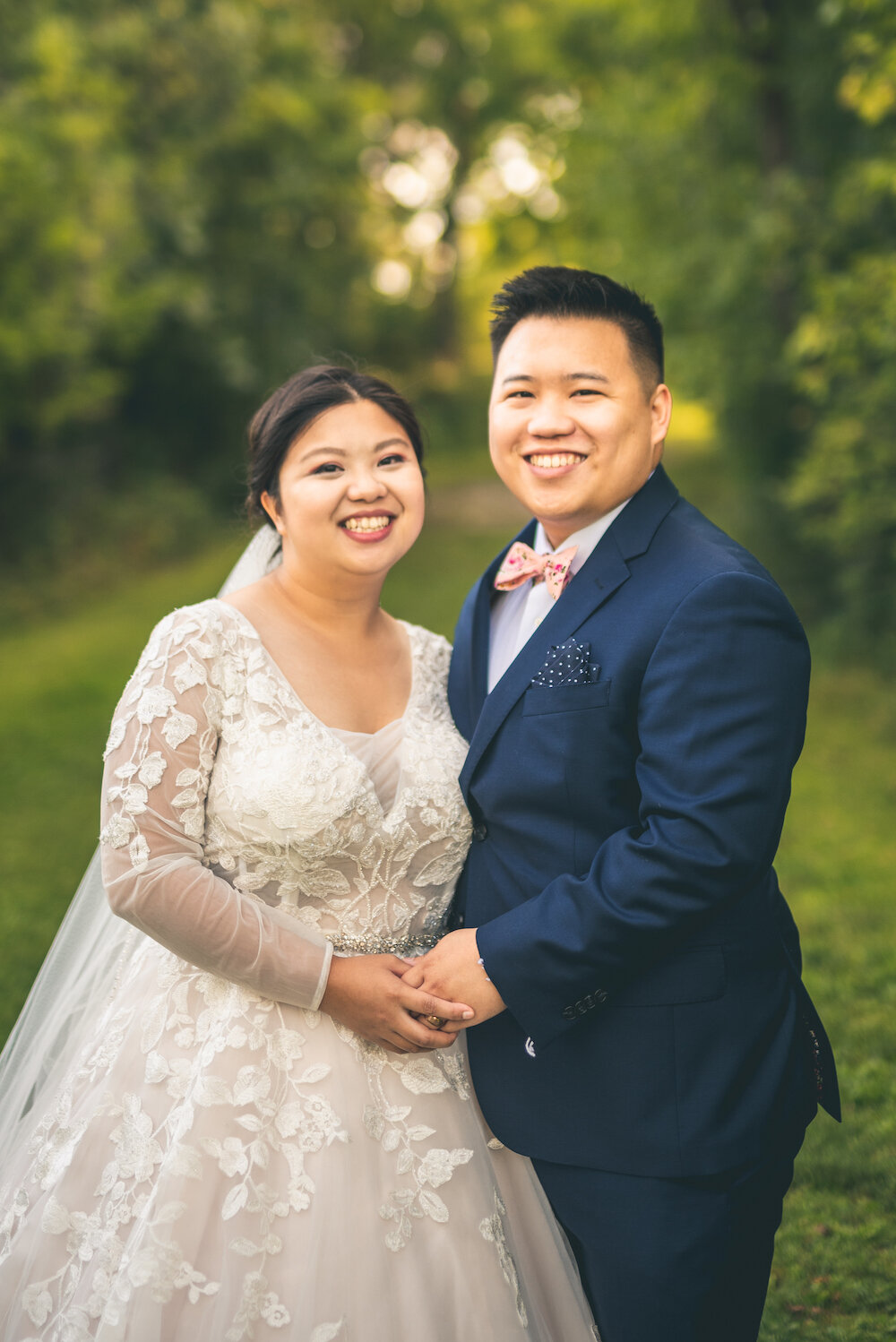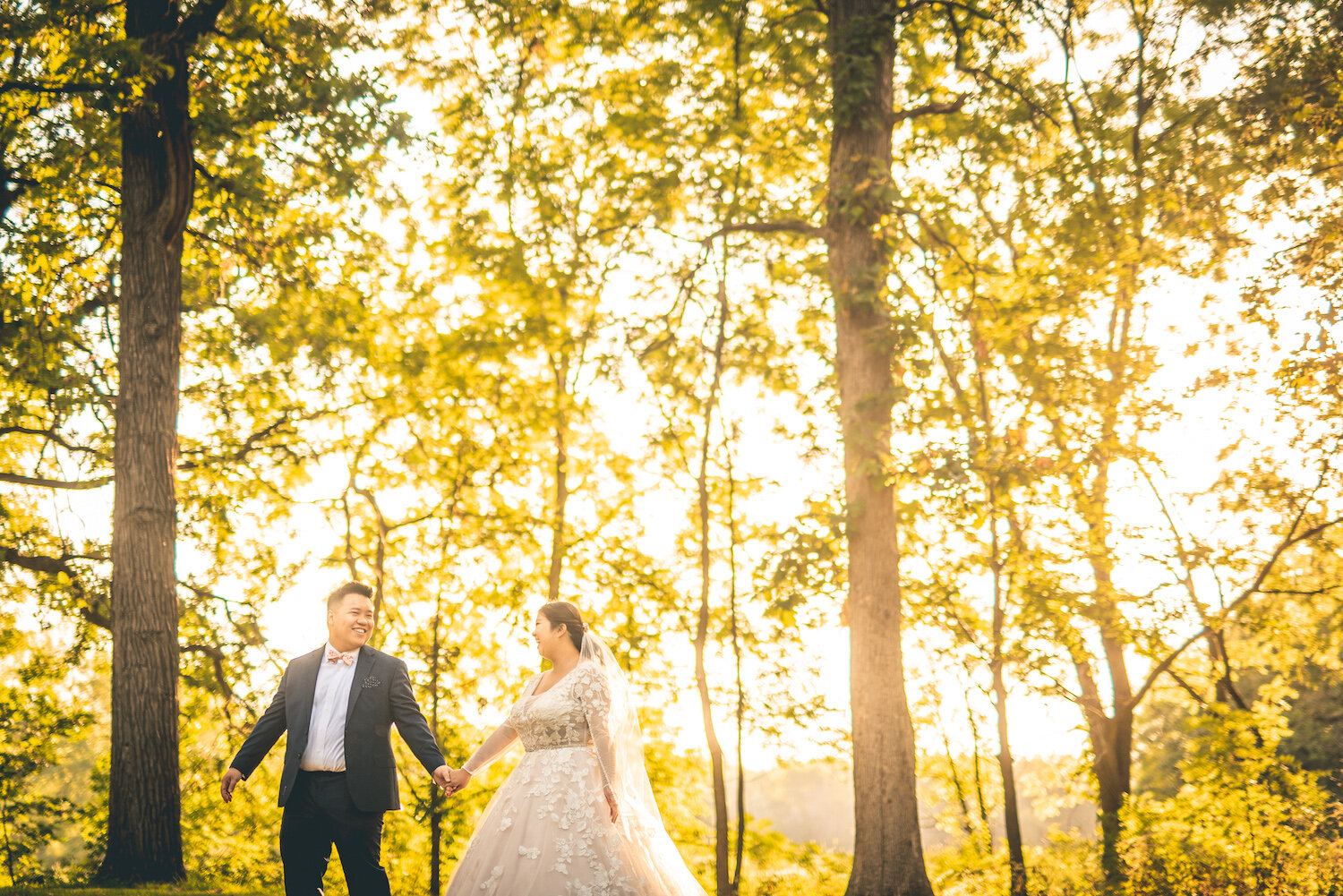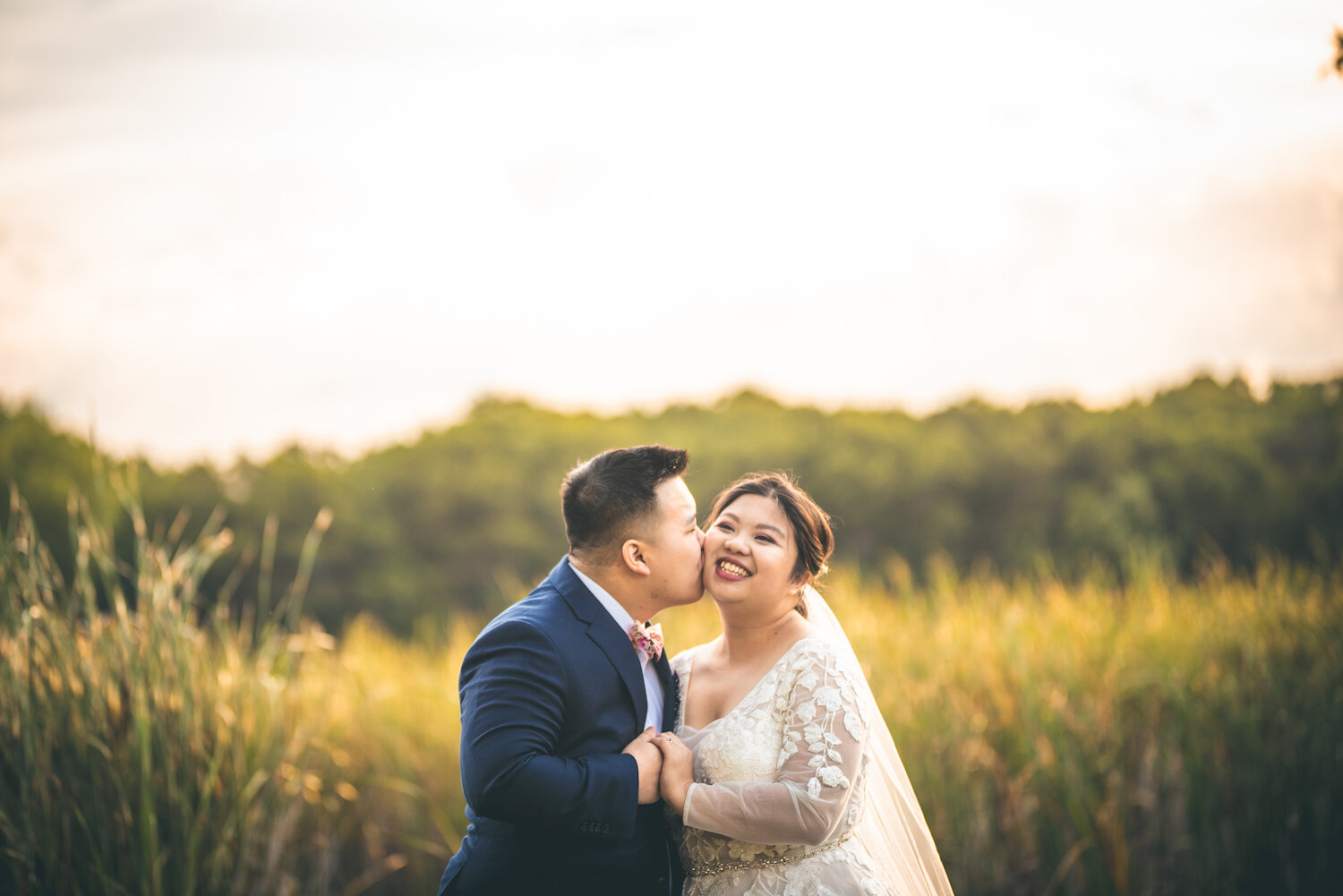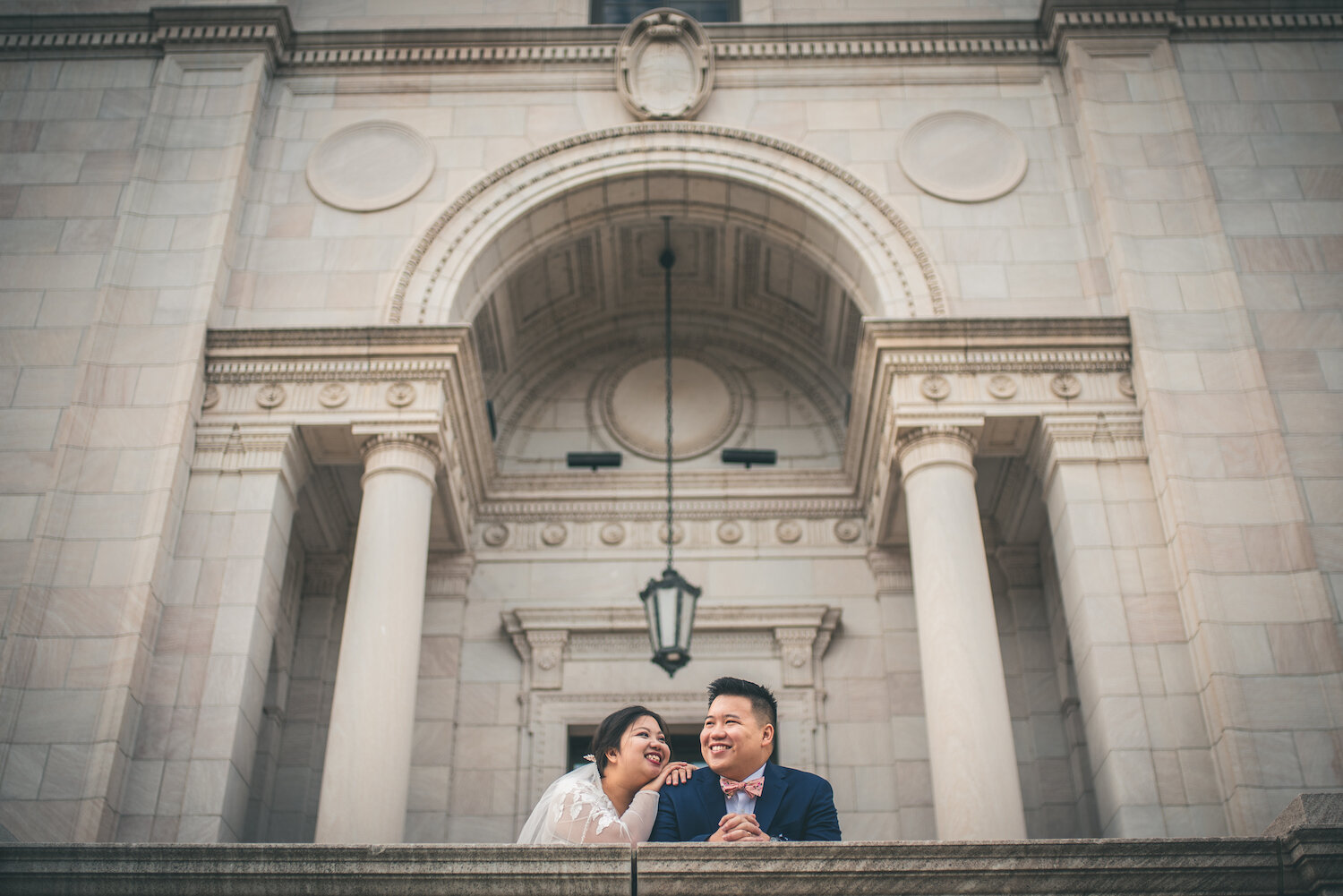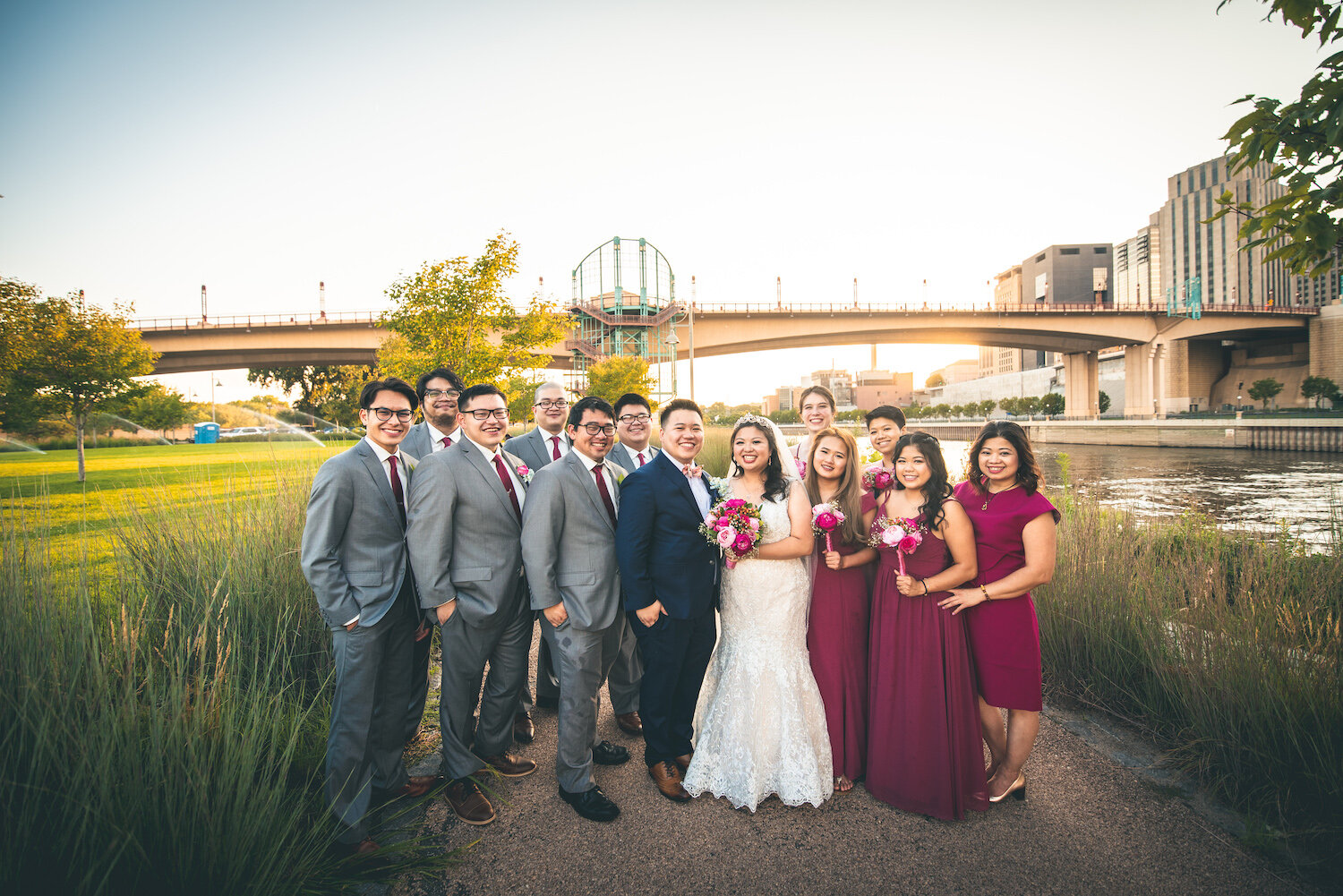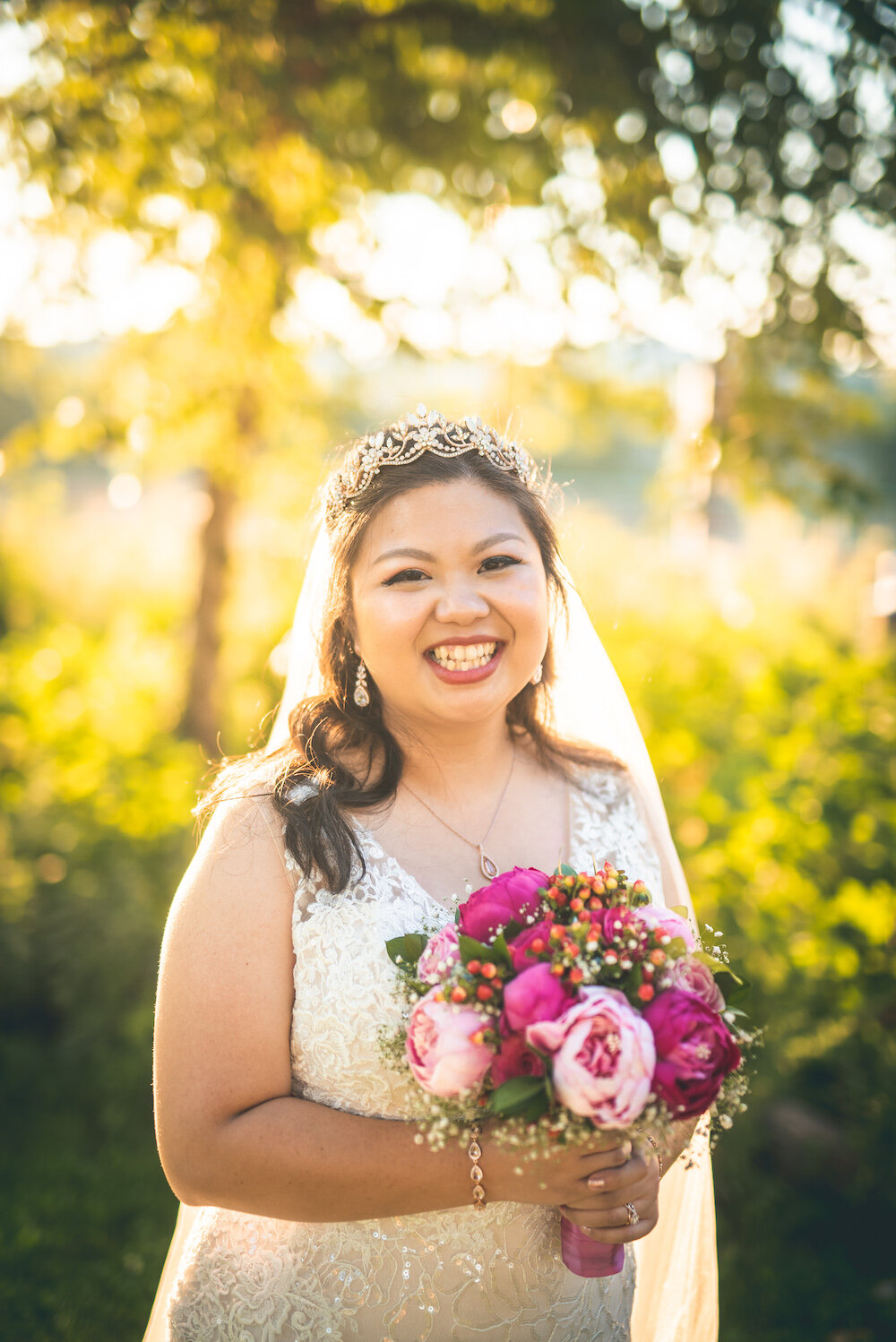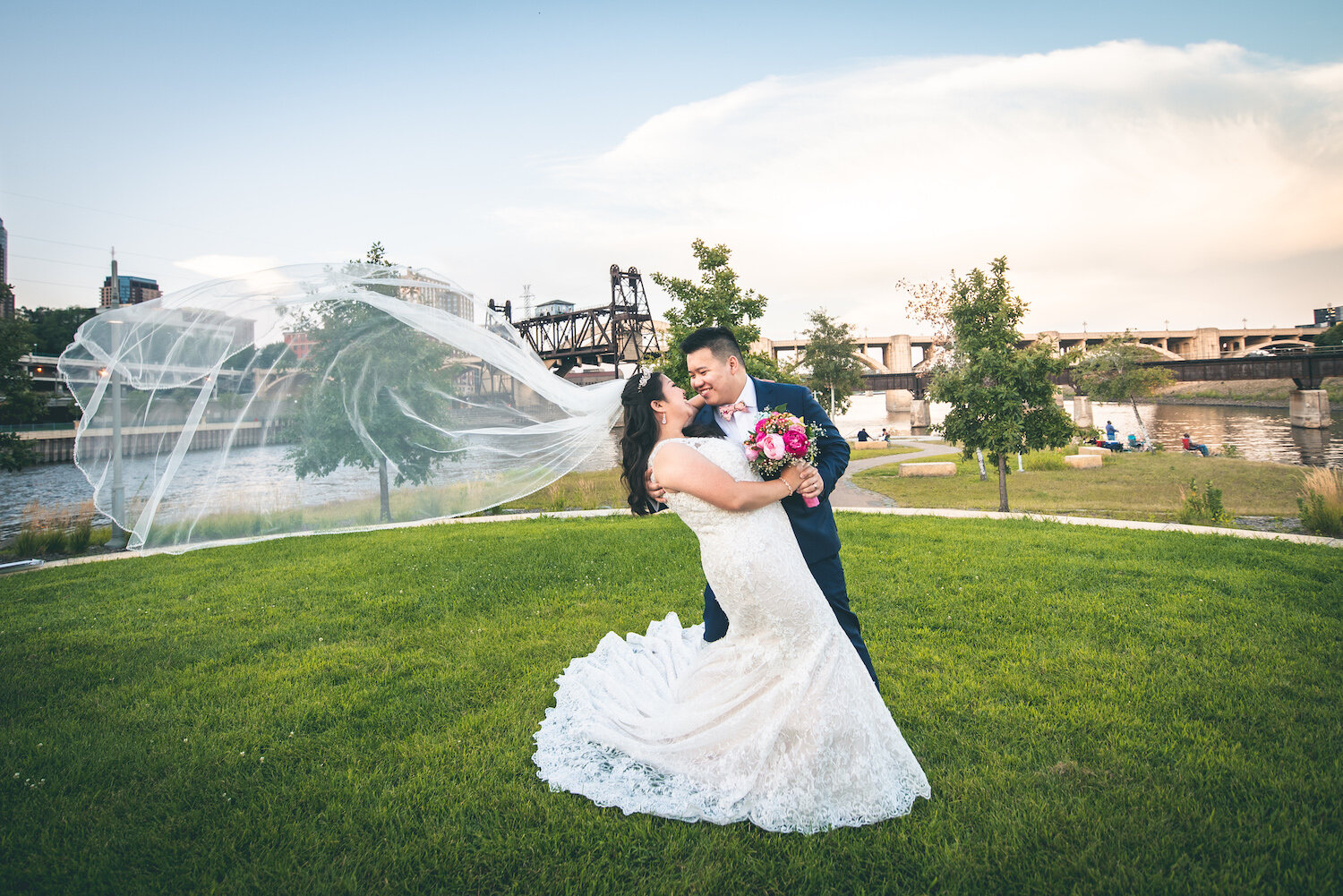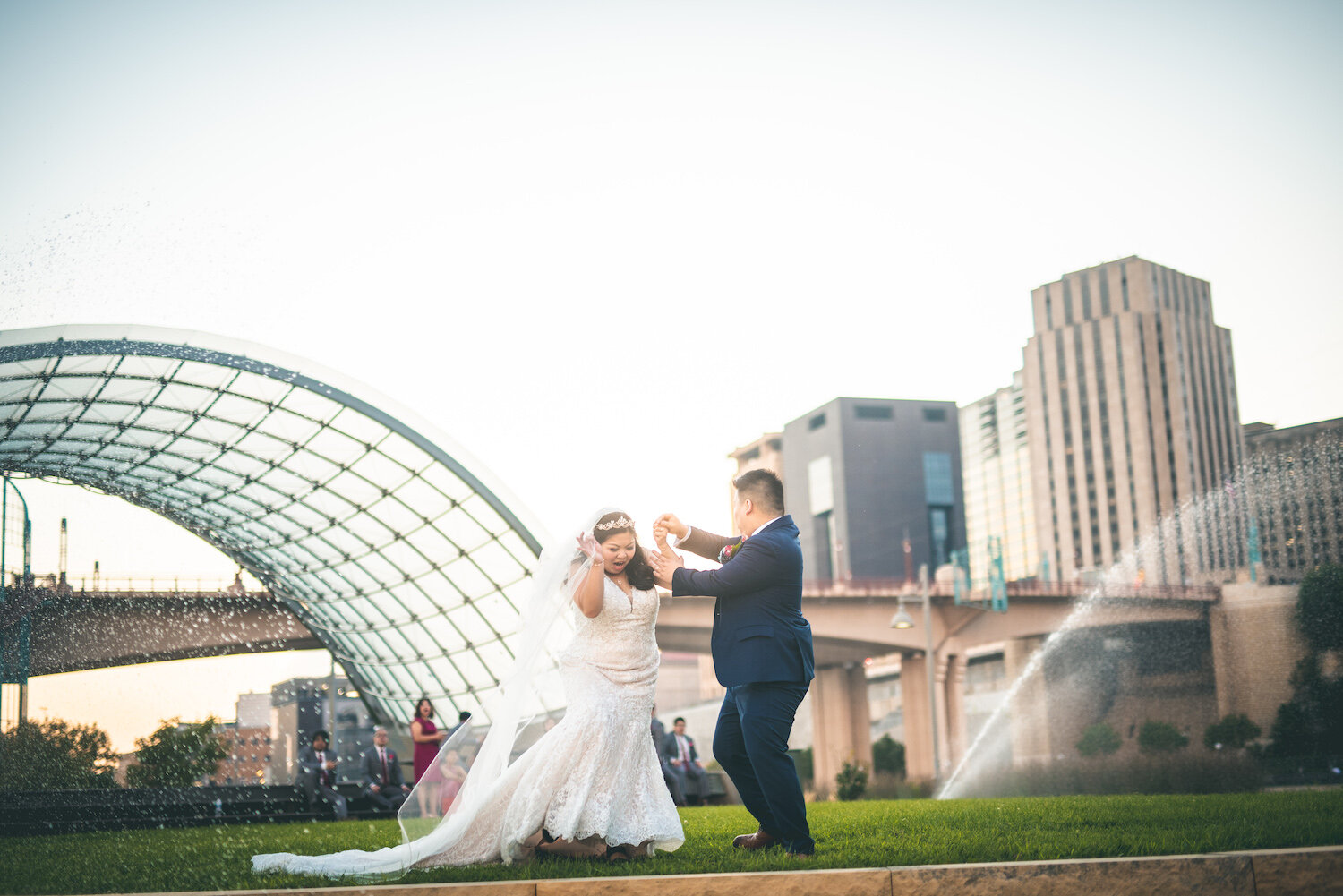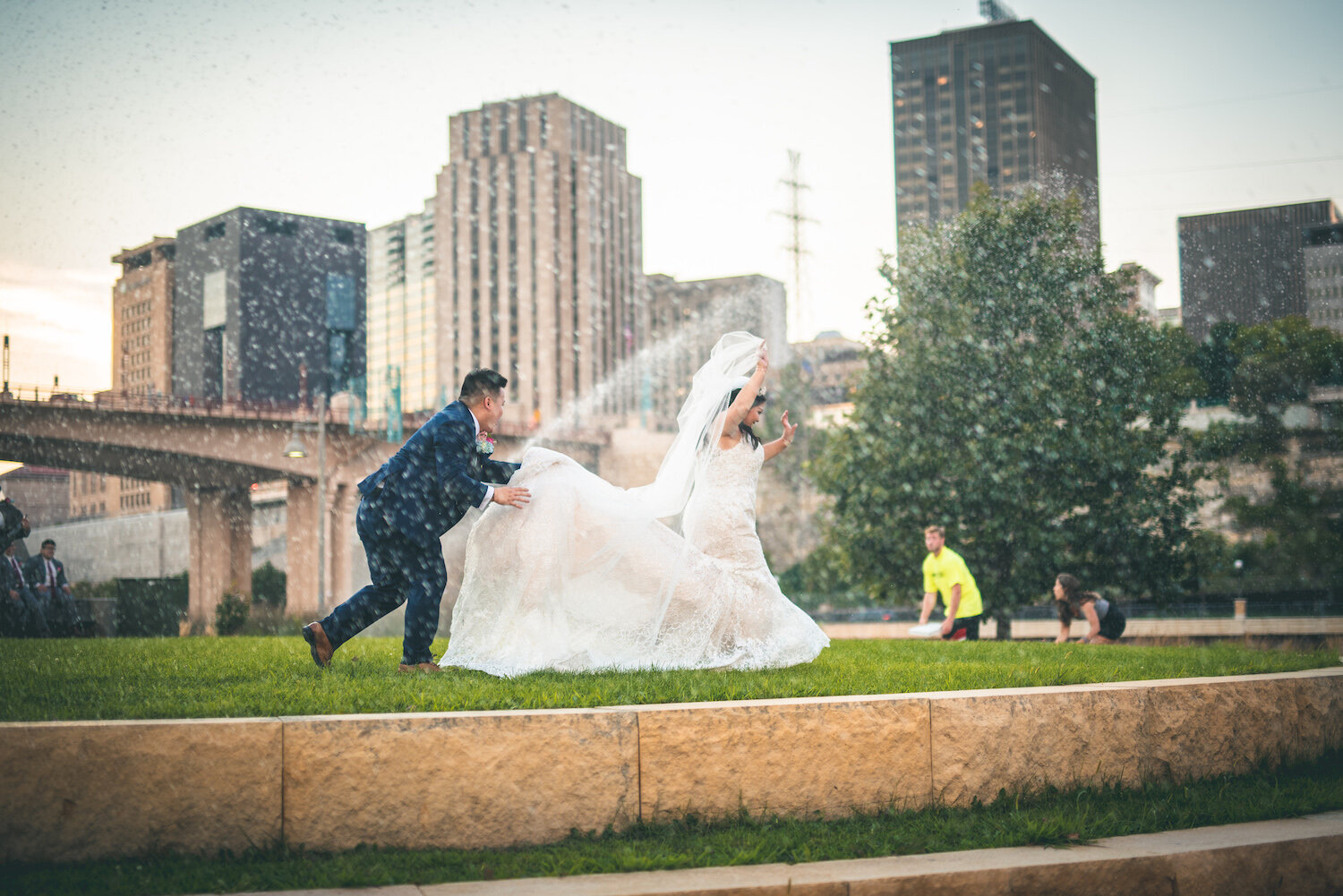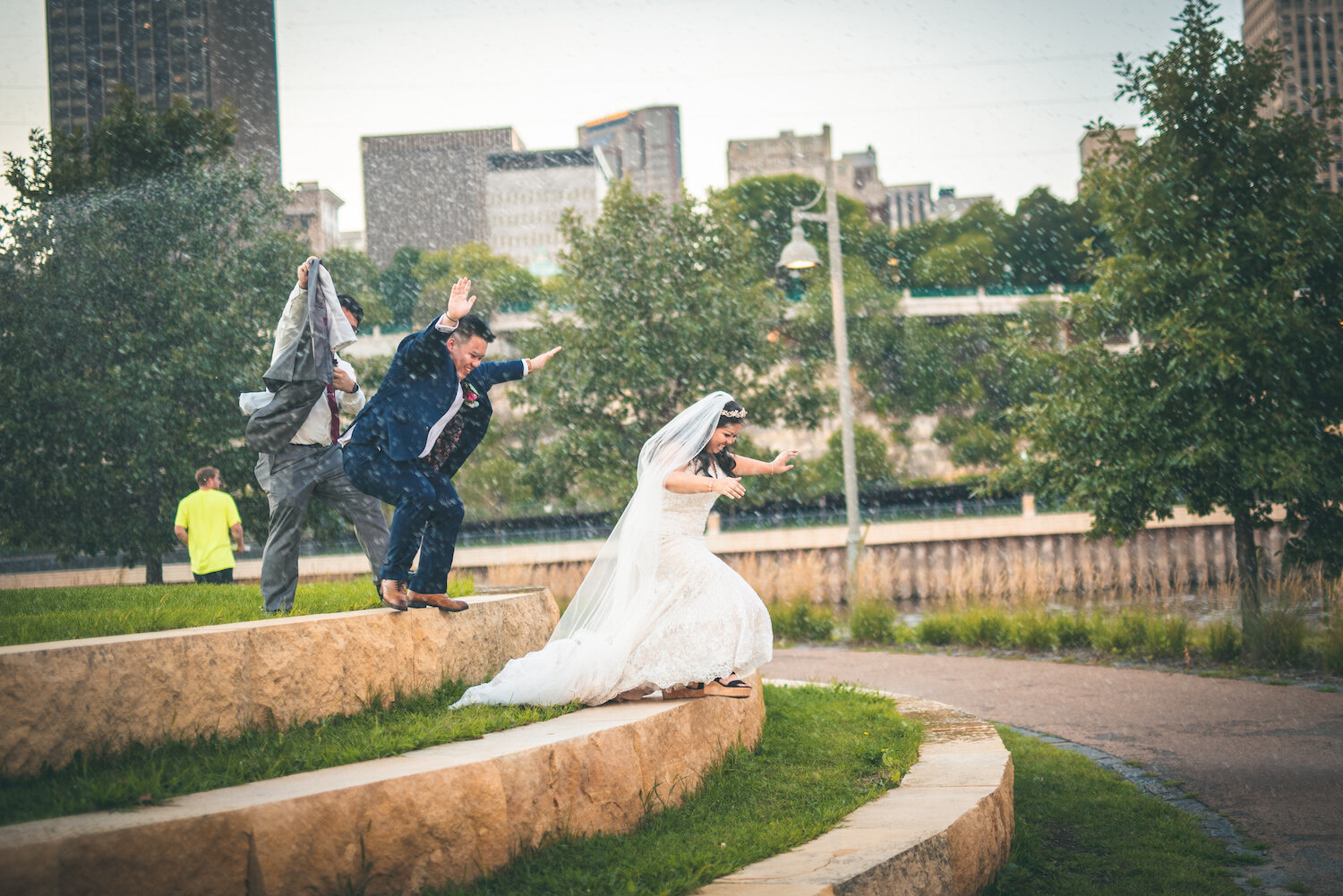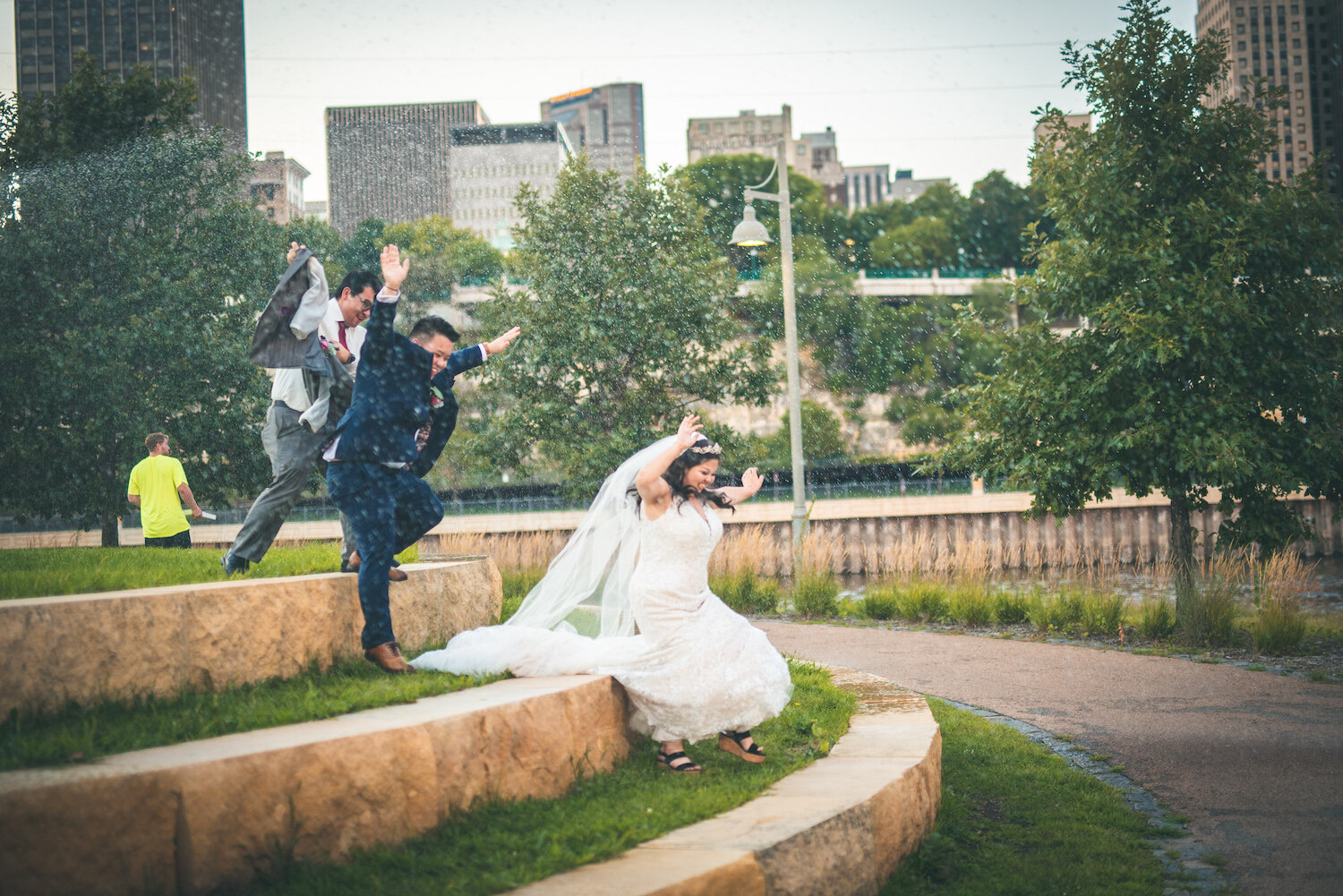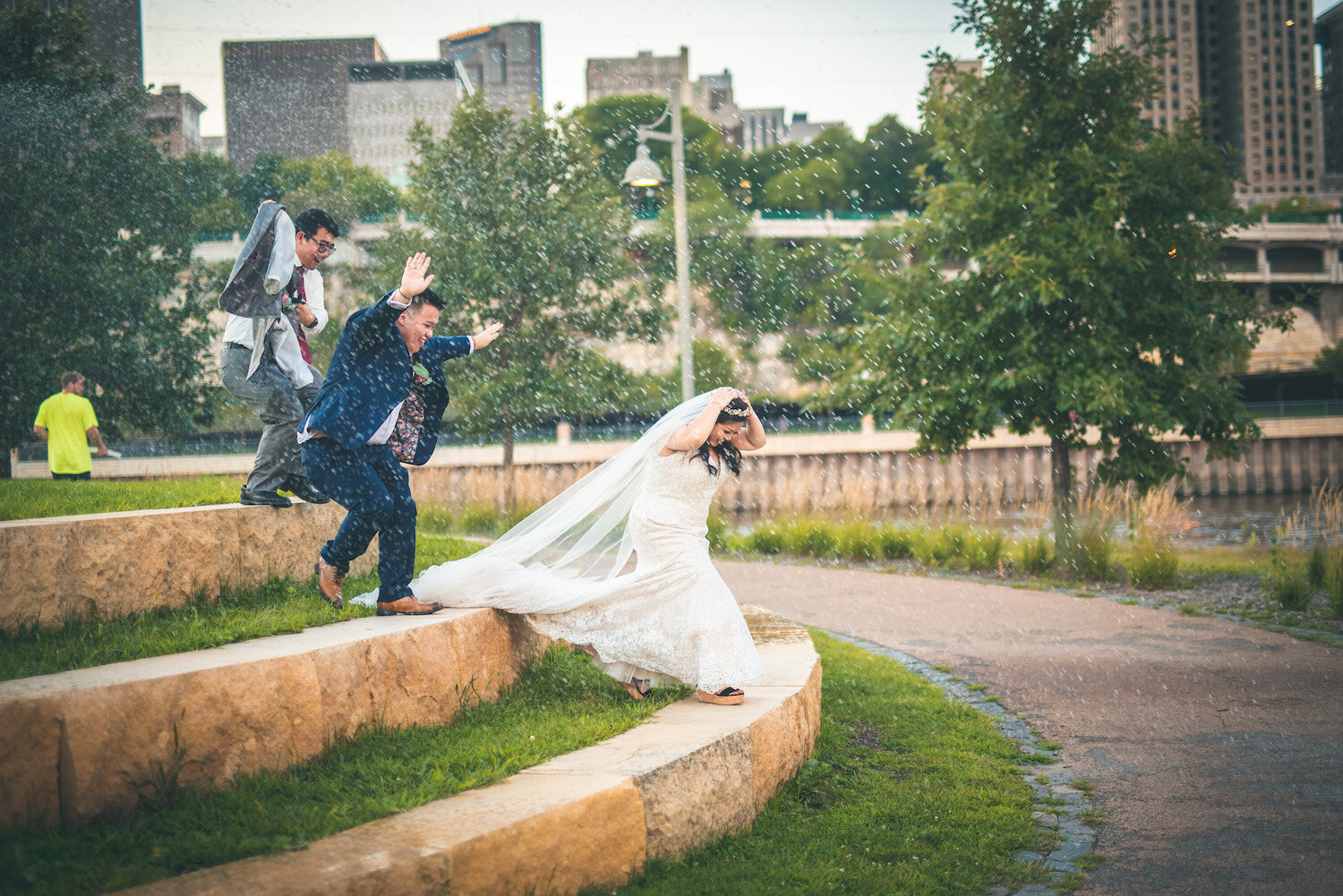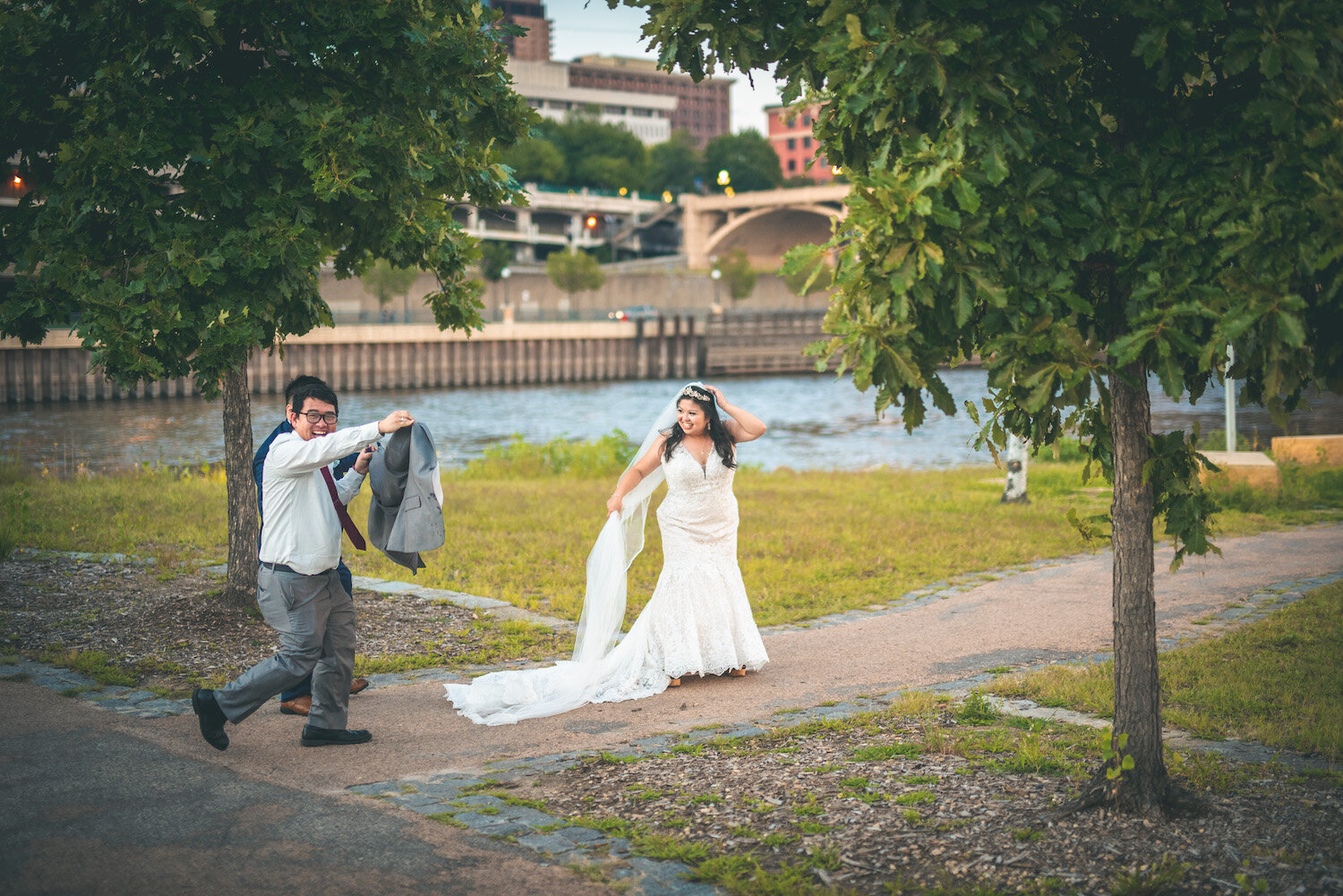After attending Princeton as first-generation low-income students, My and La Lee return to their hometown to weigh the charms and challenges of blending Vietnamese and Hmong cultures.
My + La Lee // St. Paul, Minnesota
My (pronounced “me”) and La Lee’s tea ceremony, a Vietnamese wedding tradition that included the gifting of golden jewelry, expensive liquor, and a whole roasted pig, and which was one of three wedding ceremonies they planned, had no tea.
“I had it ready in the kitchen,” Dantes, one of La Lee’s groomsmen, told me shortly after the ceremony ended, “but everyone just kinda forgot about it.”
Held in My’s childhood home in St. Paul, Minnesota, the hour-long ceremony had admittedly felt a bit piecemeal, though in a more candid than chaotic way. My's mother, who immigrated from Vietnam in the early 2000's, was decades removed from her own wedding ceremony, and with My being her first child to get married, she was understandably rusty on the formalities.
My and LaLee with My’s mother
I thought of the previous day, when I watched as the family prepared their home for the wedding, clearing space in the living room, and adding colorful ribbons and hand-made signs to imbue a more festive spirit. Mâm quả, or trays covered with a red embroidered cloth, and which would soon bear gifts from La Lee’s family, sat in an empty stack on a nearby table. One of My’s siblings dusted the shrine to the family’s ancestors in the corner of the room. Others assembled bouquets of flowers.
My with her family preparing for the ceremony the day before
Playing witness to these efforts is likely what made the event feel so sincere. The confusion was obviously not for a lack of care, only practice. The ceremony began when La Lee’s groomsmen, waiting outside the house and carrying the mâm quả filled with gifts, were invited to come inside.
La Lee’s groomsmen waiting outside the home bearing gifts
My’s family opened with prayers celebrating the occasion, and La Lee’s family representative, his cousin Ray, thanked everyone. “We are so happy to be here to join us together into one family.” He introduced La Lee’s father. “This is Neng. He’s been there with La Lee… well, ever since he was born, I guess. He’s a good father, and he’s raised an even better son.”
The room applauded, and when the claps subsided, Ray stood in place, unsure of what to do next. “Is there… anyone else I’m supposed to introduce?” he asked, looking towards My’s family. A sequence of glances signaled no one had an answer. One of My’s relatives eventually waved for Ray to conclude. “Okay, then. Well, let me officially say: let's celebrate! We hope to all get to know each other and be very happy together and have lots of food and enjoy each other's time.”
La Lee’s cousin introducing La Lee’s family (his mother and father are to the right)
La Lee's groomsmen came in carrying the roasted pig, a gift from La Lee’s family. Throughout the ceremony, many of My’s aunts and uncles shouted—or just talked loudly, I wasn’t sure which—in Vietnamese, voicing what sounded like a blend of cheerful and critical comments.
La Lee’s groomsmen carrying in the roasted pig
Many of My’s relatives stepped forward to give gifts, offer congratulations, and pose for a picture, including My’s mother, whose gift was a traditional one: a gold chain, given as a piece of jewelry but also a hedge against financial uncertainty. The gift held particular significance in her own story. Decades before, My’s mother sold the gold she’d received at her own wedding to pay for the family’s move to the United States. In return, My and La Lee gave her mother a diamond necklace as a thank you to her own sacrifices and love for the family.
My and La Lee gifting a necklace to My’s mother
The rest of the ceremony continued in a similar manner. Someone would speak, pause, glance around to confirm their actions or words were correct, and then abruptly end. But My and La Lee, who smirked at one another throughout the ceremony, were more entertained than they were bothered,
“I was expecting, like, a big disaster,” My told me afterwards, laughing, “because La Lee and I often didn’t know what we were doing, so we had to rely on my mom, who also sometimes didn't know what she was doing.”
La Lee and My in front of the gifts and roasted pig during the ceremony
The American immigrant experience is one of struggle and one of pride: struggle to learn the culture in the new land, pride in retaining that from the land left behind. My and La Lee had worried this balance would prove too tangled to make. “There was a pull,” My told me, “between the desire to do a traditional ceremony, and the desire to do it in a way that was actually meaningful for us and our families, and not just for the facade of it.” She smiled, and looked at La Lee. “But, ultimately, we were so happy that both our families got to experience the ceremony.”
My and La Lee posing for a picture after the ceremony. The banner above them says “Vu Quy” which roughly translates to “leaving for her husband’s home.”
My was born in Vietnam as the youngest of her siblings, and immigrated to the US when she was five years old. Where some of My’s siblings, the oldest of whom is 14 years older, hold vivid memories from their time in Vietnam—the home they lived in or the trips they took as a family—My holds none. Her Vietnamese language ability also trails that of her older siblings. “Many of my siblings went to middle and high school in Vietnam,” she told me, “and so they could have complex conversations with our family, whereas I couldn’t.”
Baby My with her mother in Vietnam
Emotional isolation likely accelerated her sense of independence, which one of My’s sisters told me about. “I would say all of us siblings have very rich, immersive internal worlds. We all experience things in our own unique ways. My was the baby, the most well adjusted, and somehow survived her upbringing with almost little to none of the neuroticism we all carry. She is a ball of fury and emotion, but also the font of love."
“So I’m not that surprised that My’s the first one of us to get married,” her sister continued, “the first one to want this kind of commitment and to be able to build this relationship with someone. My is the baby of the family, but she was always the one to push us to break our walls of silence with each other and to deepen our relationships."
My with her two older sisters
My grew up in a neighborhood called Frogtown, a two square-mile horizontal strip of St. Paul located next to the Minnesota state capitol building. “It’s a predominantly immigrant and Black area,” she told me, “with many of the immigrants being Hmong, Vietnamese, and Somali. Grocery shopping for Asian ingredients was super easy, and we always had access to traditional food. We went to a Vietnamese church, and most of my friend group in middle school were other Hmong or Vietnamese students.”
Throughout the week before the wedding, My, La Lee, and I often drove or walked through the area, visiting their family’s homes or buying groceries, and My recounted a time when she’d seen tour guides from the local university walking around with a large group of new students. “You’d never normally see these college students cross into this area,” she said, “but once, they were doing some kind of scavenger hunt, and their guide was like, ‘So, this is where you can come if you ever want to get ethnic food!’” My rolled her eyes. (For anyone not already aware why using “ethnic” to describe food is imprecise at best and offensive at worst, see this short Washington Post piece.)
My and La Lee shopping at an Asian supermarket in Frogtown
When My entered high school, her mother decided to move to North Carolina and then later to Alabama, where the weather would be warmer and business opportunities—she’d run nail salons in the past—more possible. “She thought, I’ll get everything open, and then bring the kids,” My told me. “Except she didn’t realize just how stubborn her kids are. We basically all put our foot down, telling her we weren’t going to just follow.”
With the oldest of the siblings well into adulthood, and the rest of the kids united in their unwillingness to move, My’s mother was unsuccessful in getting anyone to come to Alabama, though not for a lack of trying. “The entire time I was in high school,” My said, “she was constantly trying to get us to move down.”
“Those years shaped a lot of not only my relationship with my siblings,” she continued, “but also gave me the ability to function as an adult.” My’s mother would leave an envelope of cash when she came to visit. The money would be enough for two to three months of groceries, and My worked an after-school job to help with the other bills, too.
My with some of her friends in high school
My doesn’t regret her decision to stay in St. Paul, but as she’s gotten older, she’s grown more empathetic to how her mother must have felt. “I think she really missed having family,” she told me, “and one of the reasons that I grew really close to her in recent years was that I saw how difficult it was for her to be physically away from her kids. Seeing my mom feeling like she didn't have a say in our lives anymore made me understand: this isn't what she wanted to do, either.”
Her mother did eventually move back to St. Paul, near the end of My’s time in college. “My mom moved back to Minnesota after being away from her kids for so many years and realizing there was no chance we were moving down to Alabama with her."
In our week together, My, La Lee, and I would often start our days at My’s mother’s home. Her mother, who doesn’t speak much English, would welcome us instead by feeding us warm bowls of homemade beef broth and noodles, washing large bowls of fruit in the kitchen sink as we ate. “She’s really excited for this wedding,” My told me. “My mom wasn't able to have a full wedding because there wasn’t much money to go around in the aftermath of the Vietnam war, so she felt it was important to help me and La Lee have the full wedding experience, from everything like the dress, to the Vietnamese ceremony, to the food.” Through their wedding, My and La Lee gave My’s mother a chance to re-do her own.
My’s mother (center) preparing the roasted pig for friends and family to eat
I can't remember my reaction when La Lee told me that his and My's Hmong wedding ceremony would include sacrificing chickens, but the actual event was somehow both more and less emotive than I expected.
Two days before the ceremony, La Lee’s father had bought three chickens from the local live market. He’d kept them in a large box in the laundry room, where they’d hardly made a sound, but now, as La Lee and My changed into traditional wear for the ceremony, the chickens began squawking, fighting to escape La Lee’s father’s hand as he reached into the box.
La Lee’s father grabbing one of the chickens to be sacrificed
One managed a short burst of freedom, flying out of the box and running down the hallway, emptying its bowels along the way. Blocked at the end by another one of La Lee’s relatives, it ran back and forth until La Lee’s father finally caught it by the legs. He gripped the chicken from the back of its neck, and walked into the kitchen.
La Lee’s father bringing one of the chickens to the kitchen
Hardly saying a word, another of La Lee’s relatives helped with the sacrifice, pulling over a freshly-lined trash can, and grabbing the chicken by the sides of its head. She quickly slit its throat with a kitchen knife; blood drained first in a steady stream, then a hesitant drip.
La Lee’s father and another relative preparing the chickens for sacrifice. The man in the red shirt is preparing boiled eggs and incense as an offering of food to ancestors.
An empty Coors Light box stood nearby to store the chicken, and some vaguely profound thought crossed my mind about how the moment was a kind of metaphor for the folly in seeing “American” culture and “immigrant” culture as two unconnected experiences.
They repeated this three times, until all the chickens had been sacrificed.
La Lee’s father putting the sacrificed chicken into a nearby box
“What did you think?”, Brian, one of La Lee’s Hmong friends, asked me, as he rolled up his sleeves to help pluck feathers. “I was okay until the chicken jumped out of the box,” I replied; the bird had emitted a horrible, garbled, screech, and it took a few seconds before someone managed to stuff it back into the box, holding down the sides this time for good measure. “Yeah, that happens sometimes. Chickens can still move after they’re dead, you know.” I replied that I wasn’t so sure this chicken had been dead.
Brian was empathetic but blasé. “I’ve killed probably 600 chickens in my lifetime; it’s horrible, but it’s also just culture.” He continued. “Hmong people are very used to this because we’re a people of farmers. Everyone who wanted to eat meat had to do it themselves.” He sat down and began plucking at the feathers; his girlfriend, also Hmong, came to help.
La Lee’s friends and family helping to plug feathers off the sacrificed chickens
My and La Lee’s second ceremony, a Hmong wedding that was more of a dinner with traditional elements than a full traditional ceremony, was held in La Lee’s home, where he lived with his father and younger brother. La Lee's grandfather, who serves as the family’s elder with the authority and ability to perform shaman ceremonies, began by inviting and welcoming My's spirit into the home. He then asked the spirits of La Lee's family to welcome My as well. I’d never attended such a ceremony before, and watched and listened with attentive curiosity.
As with the other broad ethnic categories we use in the United States to describe our population—white, African-American, or Hispanic, for example—Asian-American is a label as useful in its ability to connote similar experiences shared by Asian people in the US, as it is useless in its over-generalization of a massive diaspora of cultures and peoples.
At the apex of our nation’s collective awareness of those cultures are those with the largest populations in the US, including Chinese, Korean, Filipino, or Indian cultures. Through food, music, war, activism, or other means, they’ve wedged themselves into broader American consciousness. Beyond are the cultures many Americans know exist—Thai, Indonesian, or Pakistani, for example—but where familiarity is likely reserved to having eaten at such a restaurant a few times in one’s life, or perhaps through an acquaintance of that background.
But what of a culture like Hmong, whose existence as a distinct group many people aren’t even aware of? (I speak from my own prior ignorance, as well as that of dozens of people who asked me to give a rough explanation of what “Hmong” meant when I shared parts of La Lee’s story.) In what ways is the Hmong-American experience comparable at all to the experiences of other Asian-Americans, when Hmong-Americans have no single country that ties them together, live a history inextricable from violence or trauma, and yet maintain their unique culture with rich pride and dedication?
La Lee and My at their Hmong wedding ceremony and dinner
Numbering around four to five million people across the world, the Hmong people are an ethnic group living mostly in China, Vietnam, and Laos. They speak many dialects of their own language, practice unique customs, and overall live differently from those of the dominant population in the countries where they reside. Those differences have often resulted in a repeated history of discrimination, exploitation, and ethnic violence.
The US Hmong population consists of around 250,000 people, most of whom either trace a lineage back to, or were themselves, Vietnam War refugees. In recent decades, they’ve concentrated in the greatest numbers in the Minneapolis-St. Paul metro area. Signs of their community are readily visible throughout the Twin Cities, in the form of billboard advertisements, churches, community centers, and open-air markets.
La Lee, My and I once visited one of the most well-known gathering spots in St. Paul for Hmong people, a shopping bazaar called Hmong Village. Three-quarters of the indoor space comprised tightly packed family-run shops, selling a variety of traditional clothes, herbal medicines, toys, and other miscellanies, while the last quarter offered food in the form of raw ingredients (fruits, vegetables, spices, and meats) or prepared dishes (roasts, soups, noodles, and teas).
Inside Hmong Village
The space reminded me of bazaars I’d seen before in rural China, a sentiment My’s mother shared, saying it reminded her of markets she used to frequent in Vietnam. Signs on the walls advertised services messaged specifically for the Hmong population: attorneys, health-care providers, and car and insurance salespeople.
Advertisements inside Hmong Village
La Lee and My both visited the space a lot as teenagers—it opened in 2010, around when the two started high-school—mostly to indulge in food cravings, a habit they continue today.
My and La Lee ordering from a restaurant inside Hmong Village
La Lee was born in Charlotte, North Carolina, and though he often moved from city to city as a child, he always retained a strong sense of his cultural identity. His parents were both born in Laos, fleeing as war refugees when they were young. “I think my grandpa did fight in The Secret War,” La Lee said, “though we never really talked about it.” (He referred to the CIA’s conduct in Laos in the 1960’s and 1970’s, when tens of thousands of Hmong men were recruited to “participate in covert military operations against the spread of communism.”)
La Lee’s mother (left) dressed in traditional Hmong clothing
La Lee moved to St. Paul when he was six months old, but often migrated back and forth between there and North Carolina. “I went to five different schools in kindergarten alone,” he shared with me, “and I didn’t really understand what was going on when I was a kid.” A lot of the moving, he since discovered, was due to his father’s family being in North Carolina, his mother’s family being in Minnesota, and both families being financially insecure.
La Lee (bottom right) with his family
I asked what making friends was like for him, moving around so much. “My friends were really just my family,” he replied, noting his two younger brothers by three and seven years. "I didn't really hang out with other people, and we didn’t have playdates or anything like that.”
La Lee in his bedroom in North Carolina
Of the way his mother and father raised him, he said, “They were typical Asian parents: they wanted me to do well in school, and they didn’t really vocalize their affection very much.” Fortunately, La Lee took naturally to school, and matured emotionally even without his parents’ guidance. “La Lee was so freaking smart,” Brian, one of La Lee’s best friends from high school, told me. “Top 10 in our class. But he’d never let that get to him, or look at the rest of us any differently. He’s so, so humble.”
Brian continued. “La Lee is one of those people where you could basically pick him up, put him anywhere, and he will survive.” He gestured around him, referencing St. Paul. “He’s like a lot of people here, people who just have zero quit.” Other friends described him to me as balanced, analytical, and extremely loyal; they’re also amused by the fact that people’s first impression of La Lee is often that he’s intimidating. “La Lee is just the biggest teddy bear, once you get to know him,” one of them told me.
When I asked La Lee about this, he replied, “it’s not like I don’t like being friends with people, but I would just rather have, like, two or three high-quality friendships, than a dozen low-quality ones.”
La Lee (right) with friends from high school. Brian is in the white shirt
La Lee (center) with his brothers
La Lee with his parents and brothers
La Lee has worked hard throughout his life to provide resources for his family, and he carries his culture and achievements with a confident sense of pride. He’s also aware that ready acceptance of familial and cultural responsibilities has led him to inherit traits he’s proud of, as well as some he’s more inclined to blot out. He sees a lot of his father in himself these days, and gave me an example. “When there’s a problem and I honestly just don’t feel like dealing with it, I’ll just say ‘Don’t worry about it’ and try to wave it off. My father does that all the time, too.” My, sitting next to La Lee as he spoke, rolled her eyes and added, “I hate it when he does that!”
Many of La Lee’s conversations with other Hmong friends venture back to their unique culture. More than once during our time together in St. Paul did someone mention a famous individual in their community—a singer or dancer, usually—and a knowing sound of approval be made in response.
These kinds of small conversations only mildly contribute to La Lee’s own sense of comfort and community in St. Paul. But, with the rest of life spent among people with whom these conversations are impossible, the reminder of Hmong culture they provide is still meaningful.
After the chickens were sacrificed and cooked, La Lee’s grandfather once again invited the family’s spirits back to the home, communicating with them by repeatedly tossing a pair of bull horns. How the horns fell—face up or face down—represented the spirits’ answers.
La Lee’s grandfather welcoming the spirits again
Although they skipped some traditional elements of a Hmong wedding ceremony because My isn’t Hmong (they didn’t negotiate a dowry) and because of COVID (there were so few people that they didn’t do family introductions) My and La Lee did perform a string tying ceremony, called Khi Tes in Hmong. La Lee and My’s family and friends each tied a white string around their wrists, wishing them luck and happiness in their marriage and life ahead.
La Lee and My participating in the Hmong string tying ceremony
La Lee’s relatives also invited them to take a few shots. Brian, the friend who’d asked me earlier about the chickens, quipped, “This is the worst part about Hmong weddings. It’s not just the drinking. It's getting up, and then sitting down, and then getting up, and then sitting down, and by the end you’re wasted.” My, who doesn’t drink much, opted for beer. (She still registered a faint wooziness after the shots.)
My and La Lee taking ceremonial shots
Family and friends made lively conversation as everyone shared food, potluck style, that My had cooked earlier that afternoon. I asked if the bride in Hmong weddings was usually the one cooking. My and La Lee both quickly shook their heads. “Anyone but the bride, in fact,” La Lee said; scheduling conflicts caused by the pandemic made it so no one else was able to help. “I was terrified that I was gonna mess up our wedding dinner,” My said, “and that La Lee’s family was gonna be like, ‘Maybe you should have gotten yourself like a real Hmong wife instead of this girl,’ so I was very relieved when people enjoyed the food.”
My and La Lee joining their families and some friends to eat after completing all the traditional elements of the Hmong wedding
Carved above the entryway to McCosh 50, the largest lecture hall at Princeton University, and capable of holding more than 450 students for the most popular classes or highly-acclaimed speakers, are the following words:
Here we were taught by men and gothic towers
democracy and faith and righteousness
and love of unseen things that do not die
Photos of the carved poem at Princeton University. Credit
The poem, written by an alum of the university from 1914, is best read slowly, with ample time given to ponder the philosophical gravity of each of its twenty-three words. Time which is, unsurprisingly, rarely available to a student, whose immediate thoughts more concern how to make the classroom’s floorboards not wince so loudly while trying to join an already-begun lecture. (Yes, I speak from personal experience.)
Photo from inside the McCosh 50 lecture hall. Credit
Attending Princeton is a unique experience for each of its 5,400 undergraduate students, in large part because of how the students are themselves unique. They arrive having grown up in hundreds of different states and countries, speak an equally varied number of languages, and have thousands of unique talents and goals.
They also speak different social languages. Those more familiar with the university—15% are children of alumni—arrive already familiar with the unique verbiage of campus life: Reunions, Eating Clubs, Precepts, The Street. Others arrive knowing no one, and have very little sense of what life will be like on such an acclaimed and intimidating campus.
Where the experience across the student body is arguably least unique, though, is in the students’ economic backgrounds. The university often likes to emphasize that over 60% of its students receive financial aid and that its program, calculated from a student’s household income, is entirely grant and need-based. The university definitely deserves recognition for graduating its students with comparatively little debt: ~15% graduate with any at all, with an average amount of $10,000, compared to ~70% and $30,000 nationally.
A screenshot of this page detailing Princeton’s financial aid
But equally as impressive as 60% is its complement: 40% of students are on no aid, whatsoever. Most of these students’ family incomes likely exceed $250,000/year, around four times the median household income in the US. 72% of students come from the top fifth of incomes in the US. Just 2% come from the bottom fifth.
A student’s financial background is not, to be sure, a direct implication of how he or she will act. Nothing says that a family that has worked hard to save and pay for a child’s education will send a student who takes that gift for-granted. But coming from a low-income background, or simply one where the notion of scarcity is the norm rather than the exception, can fundamentally change life on campus, as both My and La Lee attested to.
“I think for me,” My began, “freshman year was so isolating and overwhelming, trying to figure out the social and the academic scenes, and of course the financial piece. I had seven other roommates my freshman year, and I got really close with maybe half of them.” My didn’t (and still doesn’t) drink much, and often felt she couldn’t connect with those who did. “My whole high school life, I was just so focused on school and working, that going out and getting drunk in college just felt a little weird.”
Before Princeton, My attended an excellent private high school, which would’ve been impossible for her family to afford had she not received a full scholarship. Her schedule wasn’t pretty. “I would wake up for choir practice in the morning at about 7am,” she told me, “and then have classes and theater rehearsal until 3pm. After that, I would work at my after-school job until 7pm, come home, take a nap, wake up at midnight, cook dinner for myself, and then do homework until about 3am.”
My with a friend after a theater performance her Senior year of high school
“I knew I couldn’t do the same schedule as what I did in high school,” she said. “I wanted so badly to join an acapella group my freshman year. Not getting in one, while watching all my friends be in one, and then having to shift my expectations of what success and life would be like, was extremely difficult for me.” I nodded in assent; I also experienced very similar emotions my freshman year at Princeton.
“It wasn't until my sophomore year,” she continued, “when I joined the first-generation low-income (FLI) group, that I really felt like I had a purpose on campus.” She explained more of what she meant. “Being FLI sometimes was like if everyone else read a book that you didn’t even know existed. Things like internships or applying for certain jobs and fellowships post-grad just weren’t on my radar, and I didn't know that that was something I was supposed to be considering until I spoke with other friends.”
My committed much of her time at Princeton to furthering the voice of other students who also came from FLI backgrounds. She became the co-chair of the Princeton Hidden Minority Council (now known as FLIC - FLI Council), whose vision is “to extinguish the stigma associated with being a first-generation or low income student,” and “to advocate for the first-generation and low income voices that aren't being heard, which is seen primarily through the lack of dialogue on campus and the stigma that is attached to this part of a student's identity.” Her work involved talking to administrators to craft policies specifically for FLI students, as opposed to “Princeton students” as a whole.
She gave an example. “Freshman year, a lot of FLI students didn't have the money to pay for things like dorm supplies or travel to get to campus, and so the financial aid office introduced a move-in fund for certain students to get a certain amount of money to help with those expenses.” I sensed an incredibly deep sense of pride as My spoke. “By the time I was a Senior, you could see not just the growth of the Hidden Minority Council, but also the recognition of what FLI as an identity was on campus.” (A cursory glance at the press releases for admission from the Class of 2018, which My and La Lee were a part of, and that of the most recent Class of 2024, shows the results of these efforts, too.)
Press release from 2014 about the Class of 2018
Press release from 2020 about the Class of 2024. The focus on admitted students from FLI backgrounds is noticeably different
La Lee, like My, was also at Princeton on a full-ride scholarship. Unlike My, he’d attended a public school in St. Paul, and when I asked what high-school had been like for him, he said that it hadn’t been difficult. “I went to a lot of bad schools growing up,” he told me, “where it was pretty easy to be the best student, and so ‘being smart’ had always been easy.” (A few of his friends from high school attested to how they very much relied on his help and guidance in classes.)
Many of La Lee’s closest friends from high school were from ROTC (he’s second from the left)
“All of that ‘easy to be smart’ stuff was shut down very quickly at Princeton,” La Lee told me, “and so I had to really find a different way to identify who I was, and reflect on what really mattered to me. I realized that what mattered to me has always been the people I’ve surrounded myself by.” He made friends with others in the FLI community, and joined a breakdancing group.
La Lee on campus during an outdoor breakdancing show
My and La Lee brushed by each other occasionally in their first year, and recall that their first conversation did not go well. “We met at a Chipotle Study Break,” My began. (The university often liked to use food to bribe students to take a break from their studies and socialize with others. Chipotle was a rare and coveted treat.) “I was so excited to meet someone else from the Twin Cities, because I hadn't met anyone from Minnesota, and I felt very isolated and alone my freshman year. I asked him all these questions, and I think I kind of overwhelmed him, because he immediately gave me one word answers.” My laughed. “Clearly, his focus was on the Chipotle.”
Fate provided both of them with another, much more meaningful, opportunity to meet. My and La Lee both spent the summer after freshman year working for the same organization back in St. Paul, called Breakthrough, whose mission is “to prepare under-resourced students for college success and cultivate the next generation of educators.” My had participated in the program herself, while La Lee was more motivated by the prospect of being close to home and with promoting education within the Hmong community. “I think it's something like only 30% of Hmong people have a bachelor's degree, while only half the kids have a high school degree,” he said.
La Lee and My at Breakthrough in 2015 on a wacky dress-up day during Spirit Week
My taught eighth grade English, while La Lee taught seventh grade math, but their bigger impact was outside of the classroom. “Part of Breakthrough is doing summer classes,” My said, “but you're also trying to build relationships with the students and motivate them so that they understand that college is a very real possibility. Because many of the students in Breakthrough do not come from an environment of people talking about college and what it’s like, or that it’s affordable even if you come from a low-income background.”
The two served in the same advising group, helping young students with their studies or providing mentorship, and became close friends with one another. My was the first to suggest that their feelings could lead to more than friendship, and La Lee agreed. When they met for their first date at the end of the summer, they had a very different conversation from the one on campus.
La Lee and My re-visiting the drive-in where they had their first date
“We were able to get to know each other in the spaces and the community that we grew up in,” My said. La Lee showed My his old high school during a few walks, sharing about what his experience there was like; what his friends were like; what his environment at home was like. “For him to know the places that I grew up eating at, because he grew up eating there too, or listen to the same Chinese songs that we both listened to in our middle school days. We bonded over that, because even though we grew up apart, we had so many overlapping childhood experiences.”
When they returned to campus for their sophomore year, neither expected their relationship to last a long time. “I knew I always cared about him, but I just kind of assumed that like, the relationship was going to end,” My told me. “I thought, cool, he’s gonna be my first boyfriend, it'll be fun. Kinda like training wheels.” La Lee, for his part, agreed when My said she’d caught stronger feelings first.
But each found more emotional comfort in the other than they expected, and though My was the one sharing more of her thoughts and words with me, it was clear, as La Lee nodded along, that he felt the same way. “I felt that it was so wonderful to have a piece of home here at Princeton with me,” My said. “Having each other to share in our challenges and difficulties of having to deal with home life, while being so far away. None of my other really close friends really understood the pressure that would come from being so far away from a family and figuring out how to financially contribute to them. But he understood the things that we were trying to balance as we decided what we wanted to do in our lives.”
My and La Lee together at Princeton
The two had a home in one another, whether they were at Princeton or in St. Paul. “When I was at Princeton,” My said, “I always had a piece of home through him, and then when we went home for breaks, we would still be together, taking the same plane, hanging out in St. Paul.” Neither had much of a cultural community at Princeton—“I think there were like, two other Hmong students,” La Lee lamented—and so they served as that for each other as well, being so familiar with what the other’s community back home was like.
La Lee and My together at Princeton before formals
The summer after Sophomore year, My took an internship in Washington D.C. with the public school system, and La Lee soon “happened” to also take an internship in D.C. (“It wasn’t by chance,” he said, smirking and shaking his head.) The two decided it would make sense, financially and logistically, to try living together. They found the experience to be very natural. “We worked really well in talking about our finances right away,” My shared, “figuring out who was splitting what costs, and we cooked together every night because we couldn't afford to go out to eat. We'd also spend our weekends together.”
My and La Lee with a friend during their summer in DC
Through the years, My and La Lee became more invested with each others’ most important friends, My with La Lee’s breakdancing group, and La Lee with My’s involvement with FLI advocacy. Evelyn, one of La Lee’s closest friends from Princeton, shared a story with me that illustrated just how close the three of them got.
“La Lee and I were elected co-presidents of Sympoh”—the name of La Lee’s breakdancing group—“and after that we were spending probably 50% of our days with each other, choreographing new pieces or managing finances and marketing.” The three—Evelyn, La Lee, and My—each joked they were the third wheel of the trio. “So,” Evelyn continued, already smiling, “when there was a wedding-themed party on-campus, La Lee and I decided to get fake married, with My officiating.”
La Lee and Evelyn getting fake married at a Princeton party, with My officiating
The setup was perfect. Evelyn’s dress, seen from the waist up, could pass as an actual wedding dress; the club hired a professional photographer to document the event; and, in an absurd touch, someone also hired an Elvis impersonator to inspire a more “Las Vegas shotgun-wedding” vibe. “Both of us were just beaming in these photos,” Evelyn continued, “because we thought it was so hilarious, and so afterwards we joked that we should post the fact that we got married as a life update on Facebook.”
“Chaos ensued with our friends and family.” Evelyn was fully laughing at this point. “People are commenting they can’t believe I’m married; people who knew My and La Lee were like, ‘Oh, no, what happened?’ And are super confused, because My also looks so happy in the photos. So less than 12 hours later, we’re deleting everything and we’re posting, like, ‘We did not get married!’”
(We recreated photos from the joke during the actual wedding, too.)
La Lee, Evelyn, and My recreating the fake wedding from their time at Princeton
My and La Lee were lucky to have entered Princeton feeling so isolated and left surrounded by friends. When I asked what their time on campus meant to them and their story, La Lee responded, “It was obviously important, since we met there, and our lives would’ve been so different if we weren’t together for it.” When they might’ve felt alienated on a campus whose social life often revolves around wealth and status, they instead felt comfort and security with one another, carving out their own unique life.
But, talking to each other as alumni, it went unsaid that the four years had also been unbelievably stressful. While My and La Lee are ultimately incredibly grateful for their time at Princeton and the opportunities afforded by their degrees, a photo that La Lee posted after graduation (which My took) best summed up his remaining feelings about college.
“A lot of people have asked me how college went”
My and La Lee’s third, and final, ceremony, a full Catholic mass conducted in Vietnamese and English, was easily the most formal. During the homily, one of the priests retrieved the cross and walked, somewhat menacingly, towards My and La Lee. He pointed towards the top. “Do you know what this is?!” he said with a voice that bordered on shouting in volume and tone.
My and La Lee glanced at each other in distress. “The… cross? …Jesus?” they answered timidly. I sensed their fear from dozens of yards away. “I felt like I was back in Sunday school again,” My told me afterwards. The priest’s intention was to complement My and La Lee’s chosen reading, a passage about loving and sacrificing for one another as Jesus did for humanity by dying on the cross. “But, it was very scary, because we were not prepared for that, at all,” My said to me, laughing.
My and La Lee facing the priest before his homily
My and La Lee had, in part, decided to perform a Catholic wedding because of My’s own wishes. “I had a very strict Catholic upbringing,” she told me, “and while that's not necessarily what I align with anymore, I do believe that there is a God and a higher being, and I still find a lot of peace in prayer.” But just as important was proving to her mother that she and La Lee were serious about their marriage. “When La Lee and I decided that we actually wanted to get married,” My said, “my mom was very adamant that I take more time. She even said I could choose to not have a Catholic marriage, because then it wouldn’t be an actual ceremonial bond between me and La Lee. In the event of divorce, it’d be an easy break, because we didn’t pledge our love in front of God.”
Her mother’s desire for a spiritual “out” only drove My and La Lee further into their dedication. “If we’re going to get married, we want it to be valid, and that’s why we did so many weddings, because we didn't want either of our families to come back at the end and say, like, ‘Oh, well, you're not really married.’” In total, they had four weddings: legal, Vietnamese, Hmong, and Catholic.
My and La Lee reciting vows during their catholic ceremony
They answered affirmatively when asked by the priest to commit to baptizing their children in the Catholic Church, and fanned themselves through longer portions of the ceremony, trying to create some relief from the summer heat and lack of A/C.
La Lee fanning My inside the church
We’d gone through a walkthrough rehearsal the day before, but La Lee still carefully checked each of his movements, turning, walking, and following directions with clear intent not to do anything wrong. He reflected afterwards on the process, made complicated by the fact that he himself didn’t grow up Catholic. “When we were going through this process—the marriage prep, the paperwork—I was like, I will do whatever it takes to make sure that My’s mom feels comfortable with this and that she knows I’m serious.”
La Lee and My recessing after their Catholic ceremony
While La Lee’s parents had quickly discovered La Lee’s relationship with My and were fine with it (“My and I took a picture together our sophomore year, and my mom immediately asked if she was my girlfriend,” La Lee told me), My’s mother only found out three years after the two had been dating, and did not comfortably accept what she saw as a hasty progression to marriage.
“Even after I told her about our relationship,” My told me, “I always downplayed it, saying ‘I'm gonna go to law school,' or ‘I'm not gonna get married until my late 20’s.’” She paused, and admitted, “But I think that that was more of a defense mechanism I used to sort of avoid her asking questions about our relationship.” Her mother was shocked when she found out the two were getting engaged just a year and a half after graduating from college.
Many of My’s mother’s issues with the marriage stemmed from assumptions she’d made about La Lee and his culture. “La Lee’s parents are divorced,” My shared, “and since my mom also thought Hmong people were polygamous, she believed that La Lee wasn't going to understand the gravity of a Catholic marriage, and that I was rushing into things because I was only 23.” What bothered My most, though, was her mother’s refusal to see La Lee’s true character, and how he was more family-oriented than My ever was herself. The proof was in their story of moving back to St. Paul in the first place:
After graduating from college in 2018, My and La Lee moved together to Chicago. They planned to live there for longer than a year, but in early 2019, La Lee’s father was suddenly admitted to the hospital for issues related to high blood pressure. “He was there for a couple of days,” La Lee told me, “and it was pretty clear that he needed my help. Not because he was incapable of taking care of himself, but because he's not an organized person. Eating right, taking medicine, that sort of thing.”
Their decision to move back to St. Paul was made more consequential by La Lee’s lifelong yearning for stability. “My family has always moved around to a bunch of places because of finances, and so stability was key for me,” he told me. “Purchasing a home, settling, our future kids having consistency in their lives. Those have always been my biggest life goals. If we did decide to go back home to Minnesota, we’d be settling down. It wouldn’t just be for a few years.”
La Lee always knew he’d eventually need to move back to St. Paul to take care of his parents. Hmong culture, like many other Southeast-Asian cultures, places a strong emphasis on filial piety, or the respect towards one’s parents and their authority. The responsibility of parents’ care in old age or sickness falls upon the eldest son, a responsibility La Lee doesn’t seem to have ever questioned or wanted to shirk. “I always knew I’d have to return home some day to take care of my parents,” he told me. “There was never any angst. It was just a given.” He expected a difficult conversation with My about moving back, especially when they’d only been in Chicago for less than a year. But she surprised him. “I expected the conversation to be a lot longer,” La Lee told me, “But My very quickly just said, ‘Yeah, let’s do it. Let’s move back to St. Paul.’” And so the two moved in the summer of 2019.
La Lee had been ready to get married since graduation; many of his friends from JROTC were already married, and some even had kids. But he’d waited for My. “I told La Lee,” My said, “you can't propose until I'm 25. Because 25, to me, felt like a socially acceptable age to get engaged, and also felt like enough time for us to live our life outside of Princeton. But our year in Chicago, both of us dealing with family issues—I think we had four funerals in that year—made it clear that we shouldn’t have to wait to get married.”
La Lee proposed by sending My on a scavenger hunt, hiding messages at places important in their story, like their first-date spot, eventually leading her to Summit Overlook Park, where they always ended their dates, and where they also did their first look before their Catholic wedding ceremony.
La Lee proposing to My at Summit Overlook Park
La Lee and My before their first look at Summit Overlook Park
Ngoc, My’s sister and her closest sibling, flew in from Germany as a surprise (inspired by this BuzzFeed article, she disguised herself as a bush,) as well as Evelyn, La Lee’s co-president from Sympoh. Phillipe, one of My’s closest friends from high school, helped take pictures and film a video.
After his proposal, La Lee worked to temper My’s mother’s worries, arranging a meeting between his parents and her. “Towards the middle of the conversation, I was just wondering, ‘Why did I bring my mom along?’” La Lee told me. “Oh my god, she was not helpful, like, she was moving towards My’s mom’s side of the argument, saying ‘Yeah, I also want them to wait! They're too young!’”
But La Lee’s parents expressing their own reservations helped. My’s mother was comforted to learn that they also took marriage seriously, despite being divorced. They all agreed that, ultimately, their children were adults, and could ultimately decide what was best for their own lives. My’s mother soon threw herself into the planning process, having waited a while for any of her kids to be married.
“Because of the nature of our families,” My said to me one afternoon, “La Lee and I have spent a lot of our lives taking care of other people.” It was heartwarming to see so many of those same people now taking care of them before their wedding.
My and La Lee think about their future using the same principles that shaped their past: connection to culture, financial responsibility, and engagement with local community.
My and La Lee with their families
“I think one of the biggest things that we talked about pretty early on was what we name our kids,” My shared. “Our names both have significance to our lives. Do we choose an Americanized Western name, or one that is Vietnamese or Hmong?” La Lee nodded in agreement. “It would feel weird,” My continued, “if our kids were named something that our parents couldn’t pronounce.” (My has a cousin with a child named Arielle, which has proven to be a phonetic minefield for her family.)
The two have, for now, decided to combine parts of each of their cultures. “They’ll have a Western name,” My said, “but a Vietnamese and Hmong middle name, and then our last names combined.” They’re playing with the idea of having each name mean the same thing: flowers, like Lily, or just the Vietnamese and Hmong words for flower, so that the child’s name would have the same meaning across all three languages.
My and La Lee also frequently discuss how much language and culture they want to pass on. “We both want our kids to be able to communicate with their grandparents,” My said, “or at the very least understand them if they can't speak back. But, at the same time, we don’t want to overload them with languages.”
“I think,” La Lee added, “we also want our kids to know how to eat and cook our cultural foods, because if they come to us and say they don’t like pho…” He shook his head disapprovingly. “I went to Georgia once to see my cousins there, and I think they’ve lost so much, because they raise their kids where they hardly ever eat Hmong food.” My continued the thought. “Food is such an important aspect of how La Lee and I connect with each other, and how we connect to our parents. I would be really sad if they didn't know how to eat a lot of the foods that we're eating now.”
The two have also thought about the parts of their upbringing they’d like for their children to avoid. “My oldest sister took on so much responsibility to take care of her younger siblings,” My said, “and part of that was because our mom just wasn’t in the place to be able to make sure her kids didn’t have to deal with all this shit. So one of the main goals of ours as parents is to make sure that we're in a position in life where our kids aren't going to have to make the kinds of decisions we had to make in life.”
My continued. “We’re lucky enough to have the education we have, and hopefully careers and financial stability that won't make it so that our kids are stressing out about how we're doing, or if they need to take care of us, or if they need to give up part of their own dreams and goals in order to make sure that we're okay.”
La Lee joked, “In 20 years, she’s the one who’s going to be bringing home the bread,” smiling at My, who laughed back knowingly. “In my family and my culture, a career is not a thing,” he continued. “My parents’ career goals were to pay the rent. And in some ways, that’s still how I look at it.”
My plans to attend law school soon, and has thought a lot about the best way to impact the future with her degree. “It’s important to me to work with communities similar to the ones that I grew up in,” she shared. “Immigrant populations, children and families that are low income, families of color. Seeing my mom come to the US not understanding English, not understanding any of the processes or policies which could have protected their family; not having that access to a lot of the information that becomes power.”
La Lee and My in downtown St. Paul
My teeters between wanting to work in philanthropy and wanting to work in law. “Do you use money to push for protections? Or do you use policy? They’re both very powerful. Either way, helping other people understand and navigate the rules of the game will be a driving force for me.”
My and La Lee also think about their place in the Twin Cities, and their lives in relation to current events. Their weddings took place a few months after four Minneapolis State police officers murdered George Floyd. My and her bridesmaids’ AirBnB was right down the street from the intersection where it happened.
I visited the area one afternoon, when the area, renamed George Floyd Square by organizers, was relatively quiet. In all four directions, protesters had placed barricades to block vehicles from entering.
The Speedway gas station at George Floyd Square
Erected at one entrance was a concrete slab with text that read, in full:
On May 25th, 2020, George Floyd was murdered by former Minneapolis police officers. This event sparked an uprising by the community in protest to systemic racism within the city of Minneapolis (the city).
On May 30, 2020, police vehicles drove through the George Floyd memorial in the middle of the night, causing the community to establish barricades to prevent vehicles from entering the intersection.
On June 2, 2020, the city of Minneapolis placed cement barricades at the street entrances of George Floyd square for pedestrian safety. For weeks, city employees and community members engaged in conversations to discuss what happens next and address the needs of the community.
On August 6, 2020, City employees informed a handful of community leaders and business owners that despite no consensus, they intend to remove the barricades the week of August 17th. This resolution outlines demands for justice by community members who do not intend to allow the intersections of 38th Street and Chicago Avenue to open up without concrete actions of justice taken by the city.
Concrete sign with a summary of George Floyd’s murder and subsequent events
Behind the slab was a boulevard, a few hundred feet long, of names, preceded by the words “JUSTICE FOR.”
Most people walked around the names rather than on top of them, and appeared hesitant to take their phones out for pictures. A smartphone camera had captured the horror of the murder, but now it seemed to take away from that horror by aestheticizing the scene.
Part of a long boulevard of names of people killed by police violence. I was not able to find the artist’s name to credit here
I brought a bundle of flowers, and admitted privately at the time that such an act felt necessary, yet ambiguous in intention. Flowers don’t bring back the dead, nor do they stop future killings. But they seemed to symbolize, however fleetingly, mourning and respect.
The memorial at the center of the intersection
Around the outskirts of the Square were other murals or pamphlets. “Educate yourself,” some said, suggesting additional reading. “Say his name. Honor his life,” others offered. Few people spoke, but some locals played music from portable speakers or sold BLM merchandise to passersby.
A mural painted where George Floyd was murdered. Someone a few nights before had vandalized it
This is not the space to have full discussions about racial injustice in the United States, and I hope not to take oxygen away from those who have written far more extensively. But I hope I can at least speak to my own emotions and reflections walking through the intersection: emotions of the gravity of being in the space, of its place in history; reflections of wrestling with whether I was honoring, visiting, or simply intruding by being there and taking photos; reminders to continue to learn and do more every single day.
La Lee and My spoke to me about their reflections, too, living so physically and emotionally close to the murder. “It was very different being here,” La Lee told me. “Personally, I never really felt the weight before. Hearing about Eric Garner in New York during college, or people in California and Texas, you hear about it, and you think like, ‘Oh, yeah, that's really bad. We should do something about that.’ Versus being here when it happened, and following the death, it being on every single news outlet, every single hour of every single day, and us paying so much attention to local politics, to the police chief, to the police union.”
My followed. “For me, it was different this time around being at home in Minnesota when George Floyd died. Because when Philando Castile died, he was also from Minnesota. He actually worked as a janitor in the high school that I would have gone to if I went to the public high schools, only like a few blocks down from my house. And I remember hearing about, from my siblings, the protests that were happening on the big highways at the airport. But I also felt distance, because nothing like that was happening at Princeton. I was paying attention, but at the same time, I didn’t try to play an active role then.”
“Whereas this time around, it happened in the area in which I grew up. University Street in Frogtown was one of the major places for that whole week of protests. My mom’s house is only a couple blocks from there. To see all those businesses that were affected by it, but also to see all the people who were coming out. Being able to see what the after effects are on a community once the news cycle ends. How does the community respond? To actually see that and learn more about our local politics.”
My saw the effects almost immediately in her own work at a local non-profit. “We had to respond quickly because there were a lot of community organizations that were affected, that basically either lost their buildings or had an increased need for family and food support, even more than just from COVID. Being able to see how the organization’s leadership responded to that, doing a really quick turnaround grant period in order to get money out to African-American focused organizations that were serving African-American communities.”
“I could see my work directly related to the aftershock of how you respond when a community has to go through something like this. And that was different. It was real life, and that was the type of organization that I wanted to work for. It’s like, okay, we have thousands of dollars that we need to get out in a week, so let’s do it. And that mattered.”
The events have also affected how My and La Lee think about placing roots in the city. “One of the things we’re really struggling with is wanting to live in St. Paul so that we can vote here, but also not feeling as confident about the St. Paul public school system because we’ve both been through it,” My said. “We debate, what is more important? That our children are raised in an open environment where they’re seeing different cultures, and where they’re not the only Hmong or Vietnamese kid, and where our taxes are supporting the city we care about? Or the specific school system they attend?”
“If we buy a house in St. Paul, for high school, I would like to send them to a private school, because I really gained a lot from my private school experience, while La Lee will talk about how conflicted he was about his public school experience, because he met his lifelong best friends there, but at the same time, they had a teacher that was drunk all the time.”
Regardless of what My and La Lee ultimately decide to do, they’re already unique in choosing to build a life together where they both grew up; after attending Princeton, most students funnel into a few major cities from the hundred whence they came. But their choice is unsurprising. Their values, well-strengthened, brought them together, and their future, full of optimism and intentionality, is only a natural extension of their lives thus far.
After their Catholic wedding ceremony, My and La Lee held a small outdoor reception on the church grounds, serving food that their families prepared earlier, and cutting a small cake they bought from a favorite local bakery.
Photos from My and La Lee’s small outdoor reception after their Catholic ceremony
My is an avid photographer, and so when most couples would’ve decided to do pictures with their wedding party right before or right after their ceremony, My and La Lee decided to take a break for a few hours in order to properly catch golden-hour light in the evening.
(Their decision wasn’t much of a surprise. A few days before, they’d committed to a sunrise photoshoot, waking up at 4:30am in order to catch golden hour light. My wore the dress she would wear at their larger, hopefully COVID-free, reception in 2021.)
Photos from our sunrise photoshoot a few days before the wedding
They chose Raspberry Island, a popular St. Paul park near downtown, for their photos.
Photos during golden hour at Raspberry Park in St. Paul
As the sun began to set on the end of our photoshoot, I tried to squeeze in one last photo along the edge of the island. My and La Lee posed, the former twirling the latter to allow her veil and dress to flow around her, when suddenly a merciless spray of water rose from the ground. The area’s sprinkler system had started fully and without warning.
“OH NO GIRL RUN!!!” a nearby picnicker shouted, as My and La Lee sprinted down a set of steps with impressive agility. La Lee instinctively grabbed the train on My’s dress to keep it dry, as one of his groomsmen sprinted over to offer his own jacket for cover.
A few days after the wedding, La Lee posted a series of these sprinklered photos, rather than any of the more formal one we’d taken together. His caption read, simply:
“The road ahead of us is treacherous, but I know I am stronger with you.”
































































